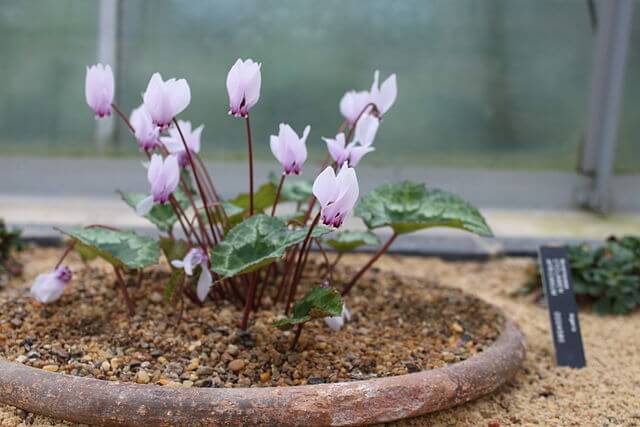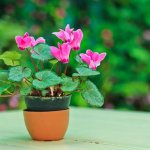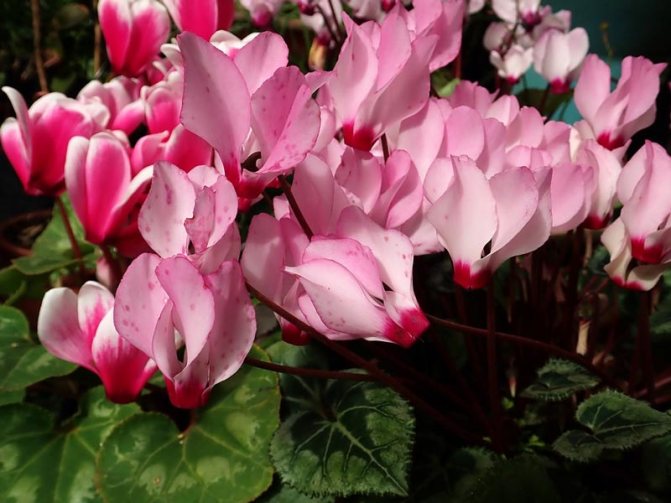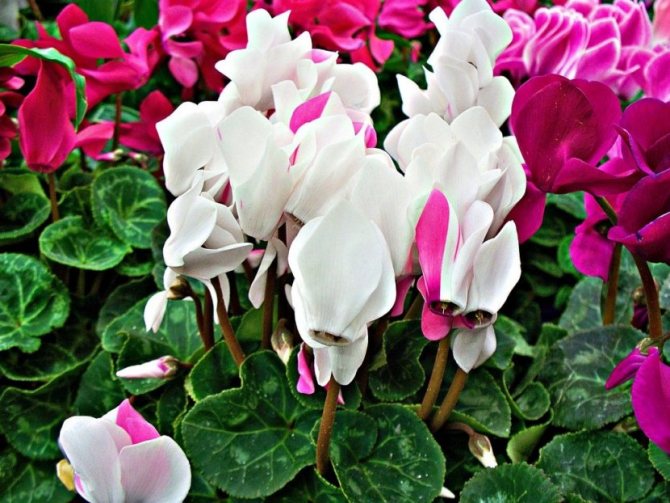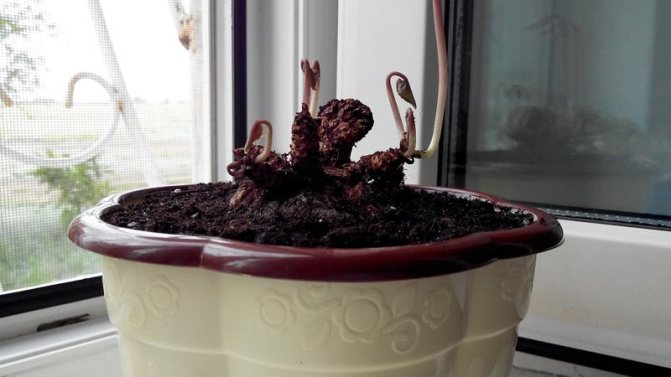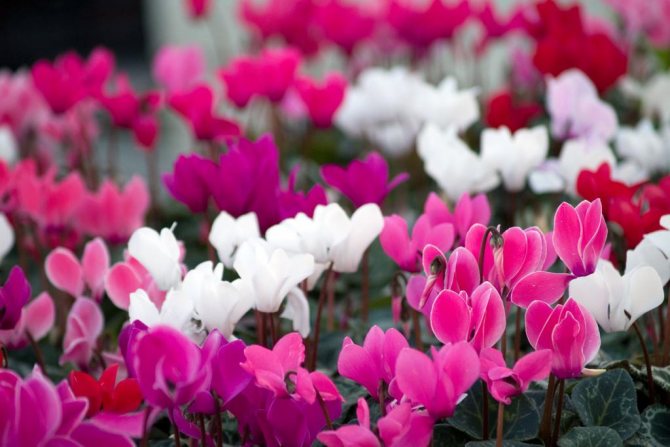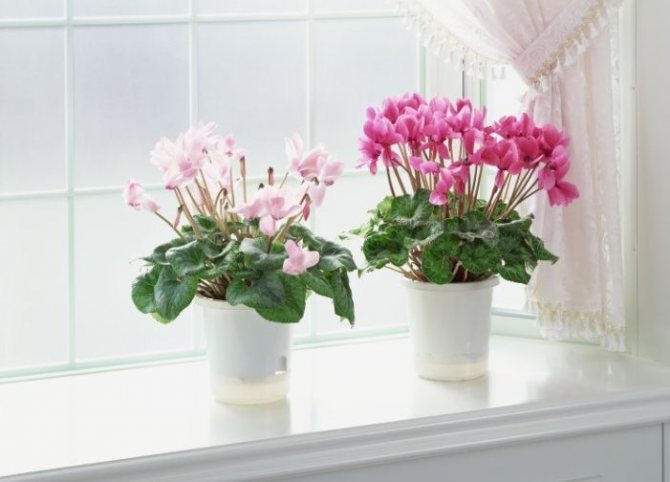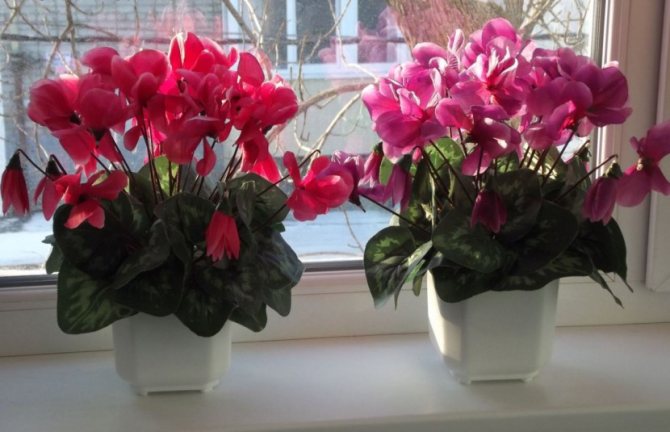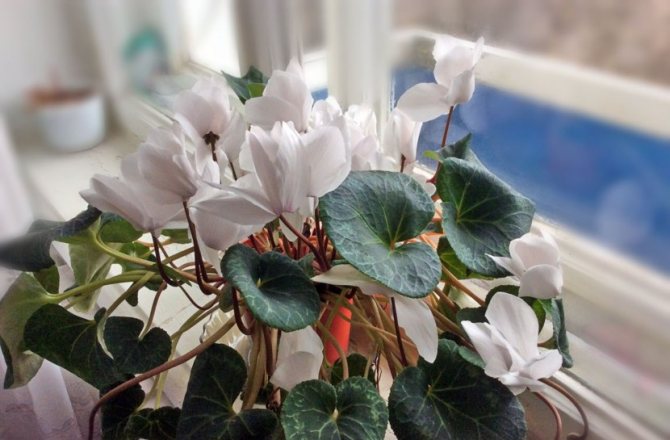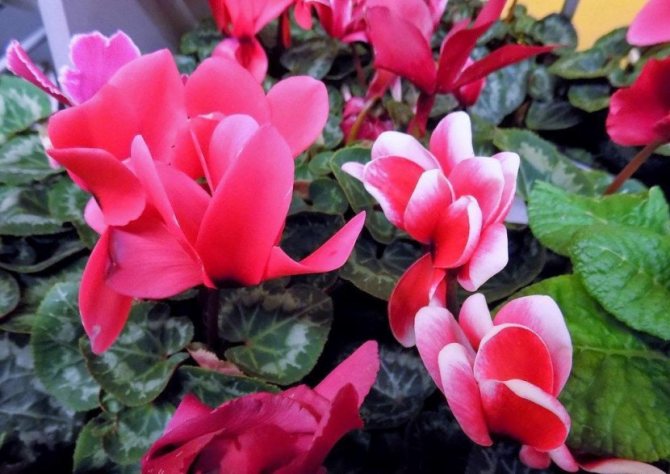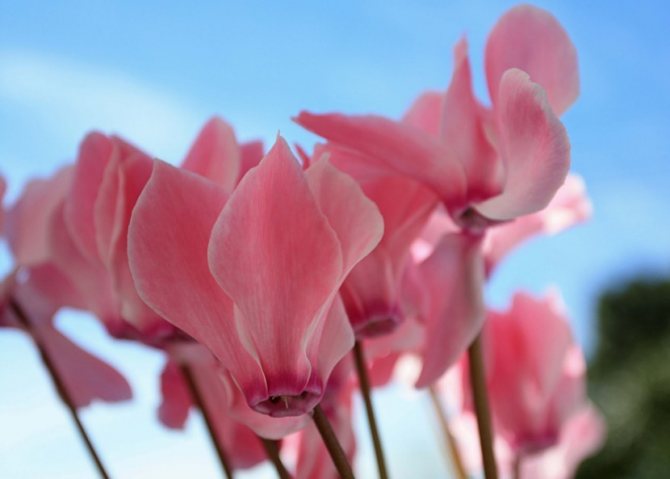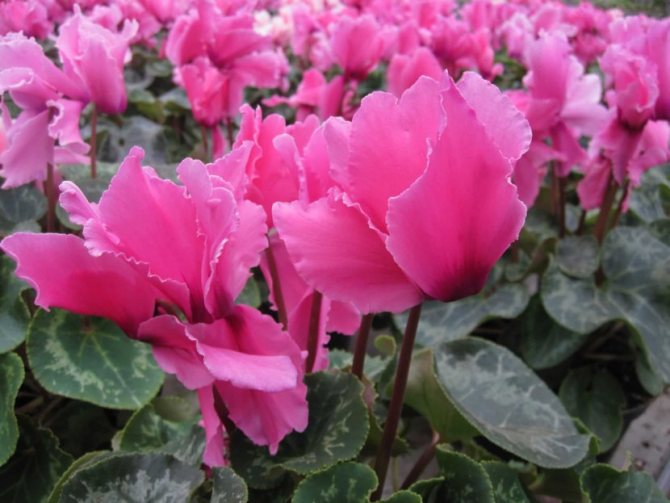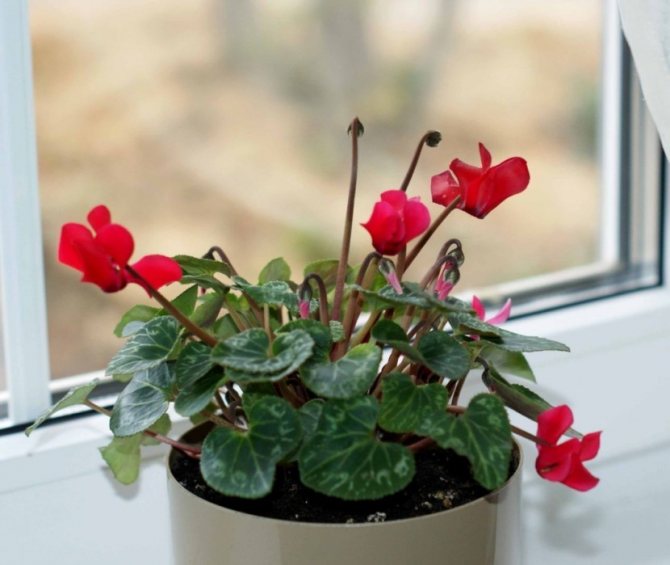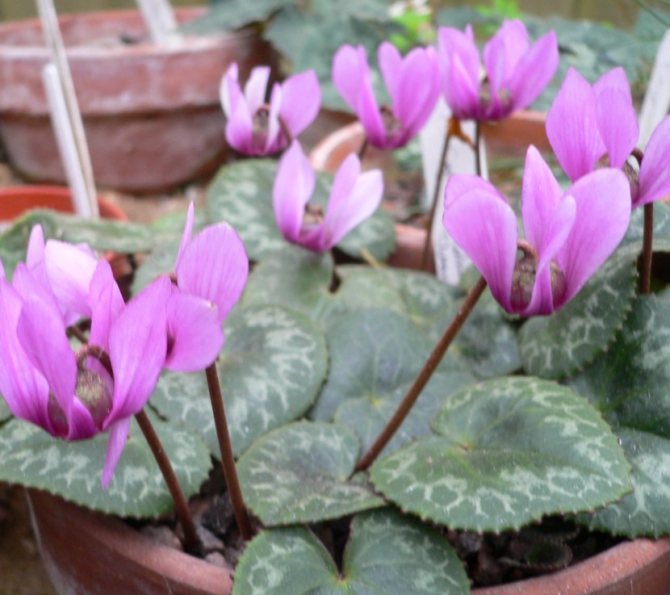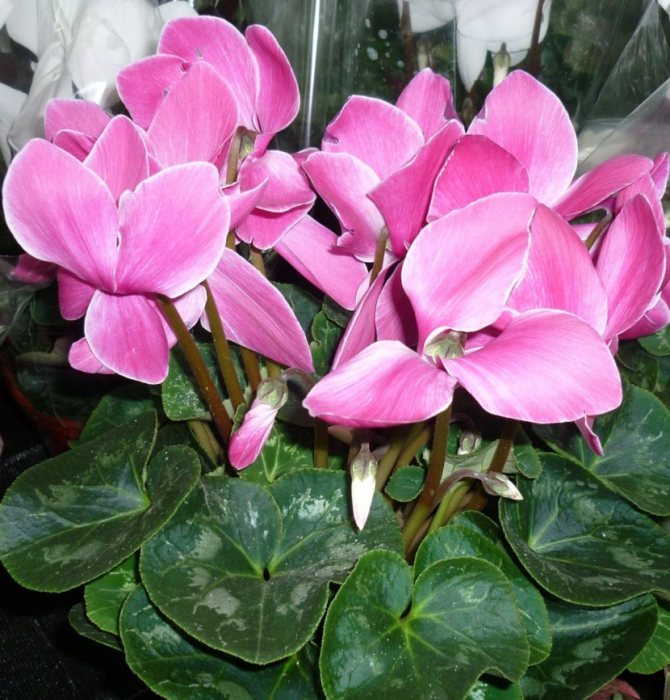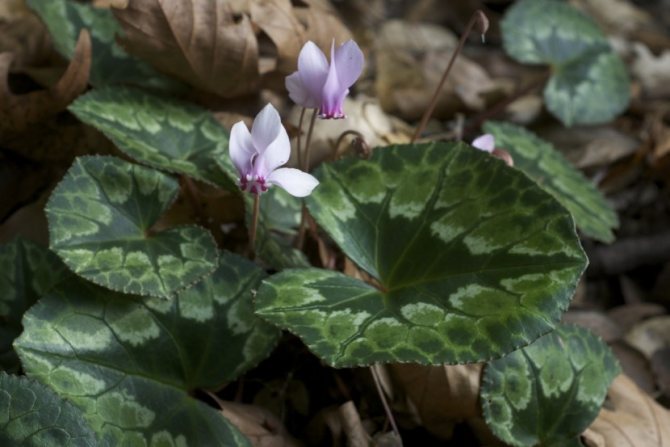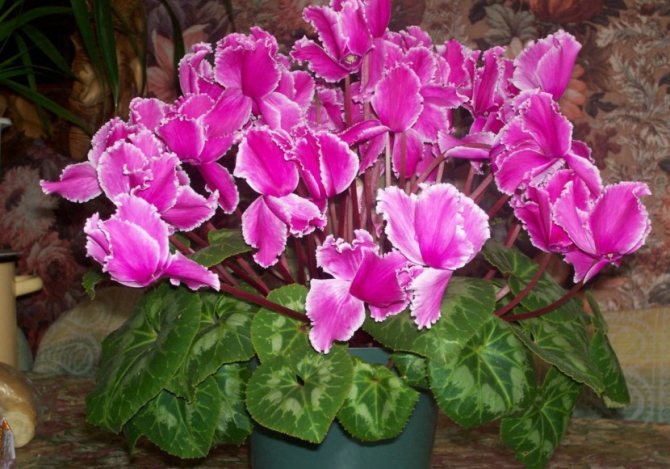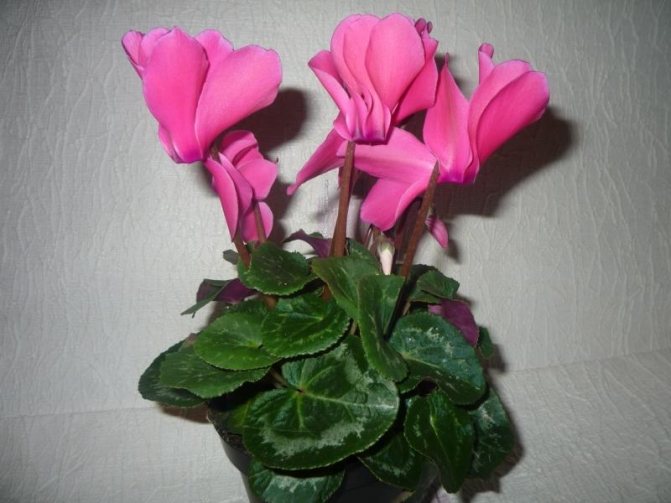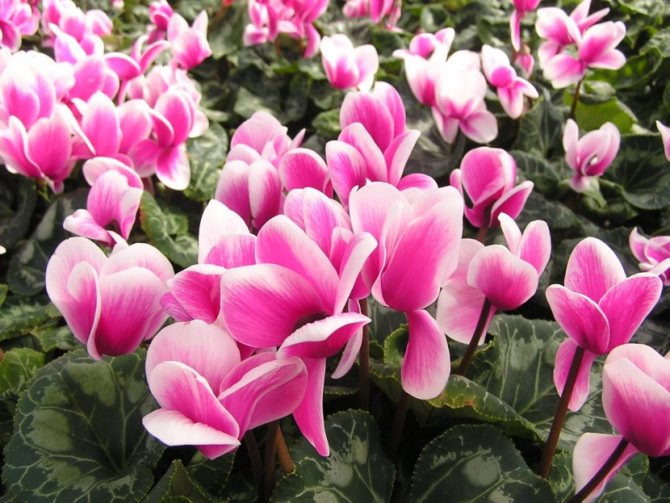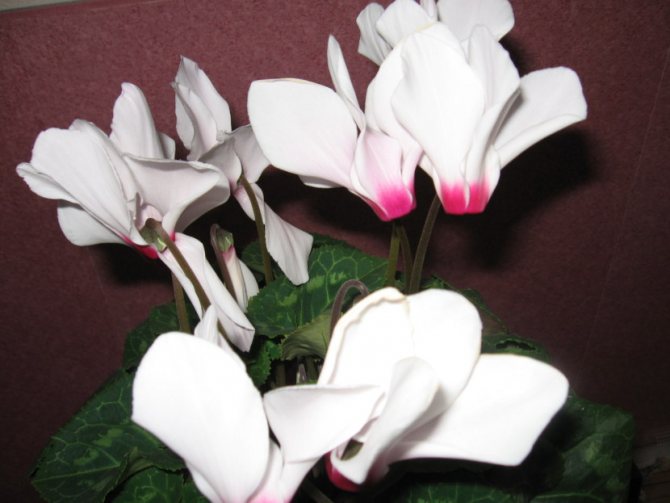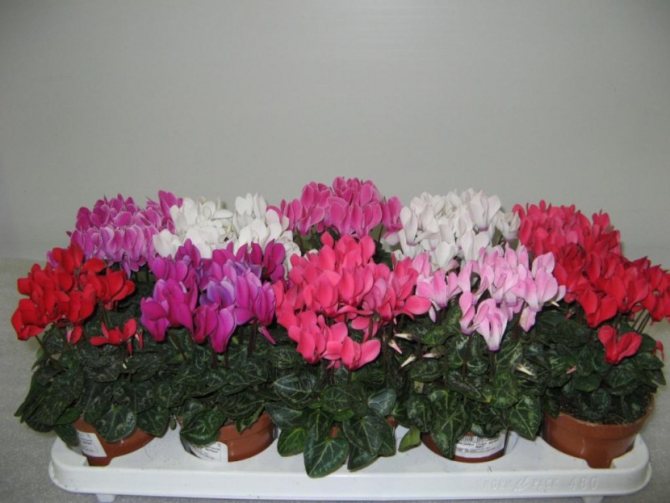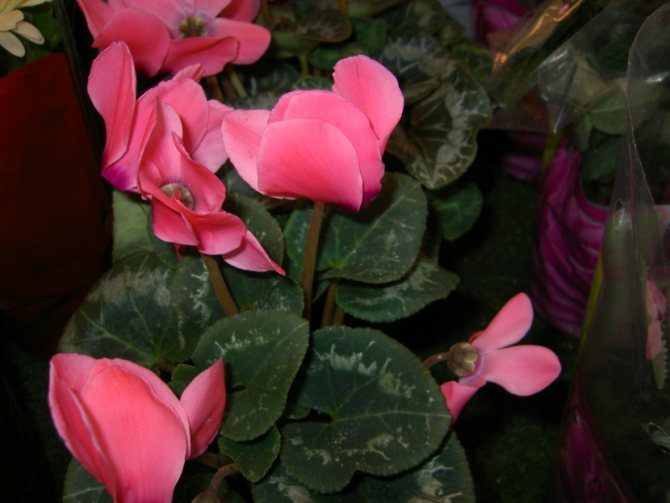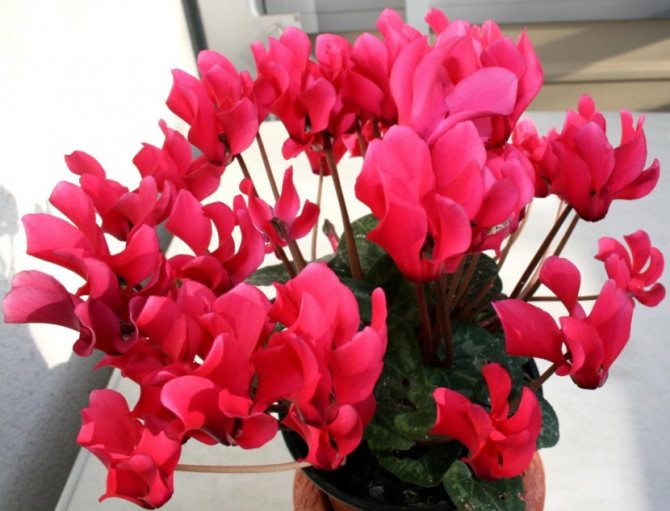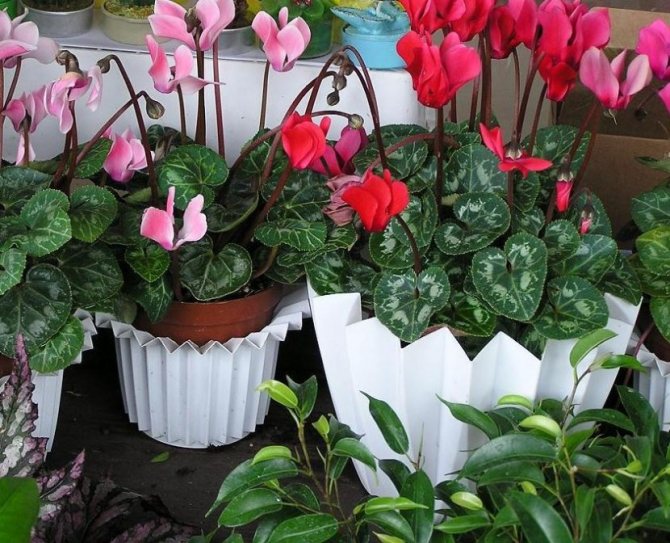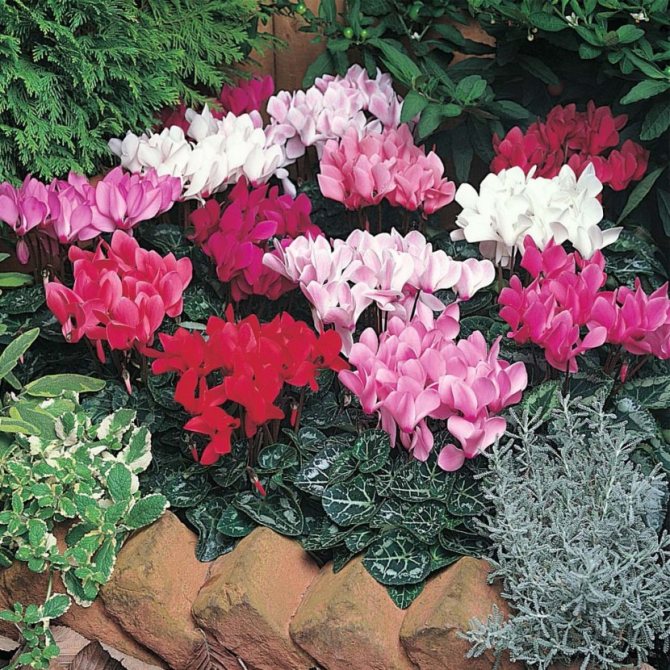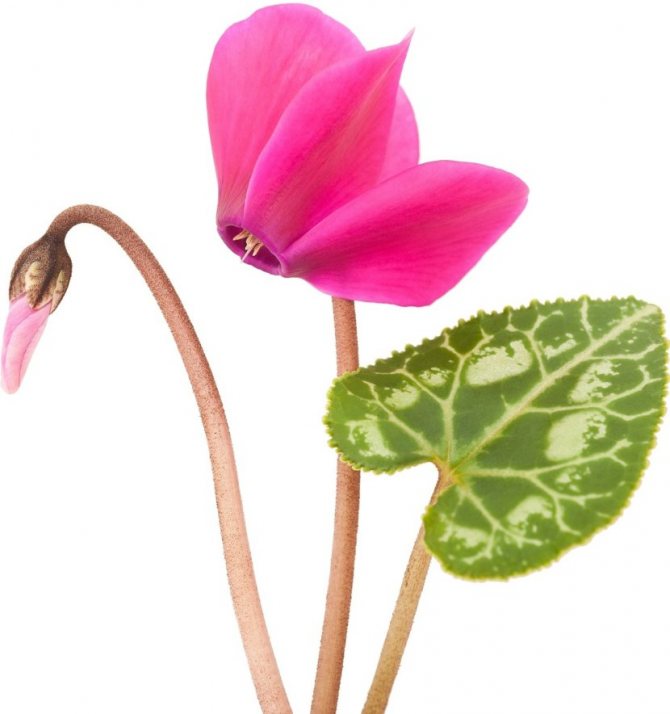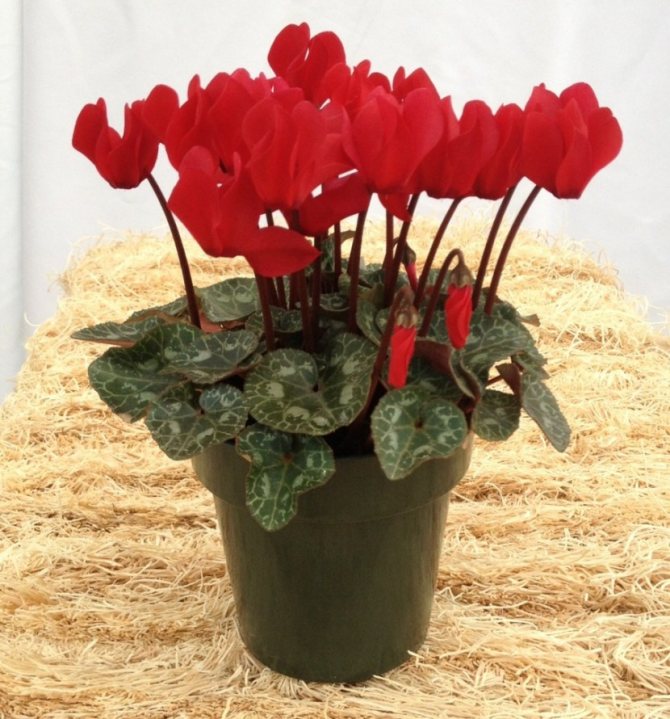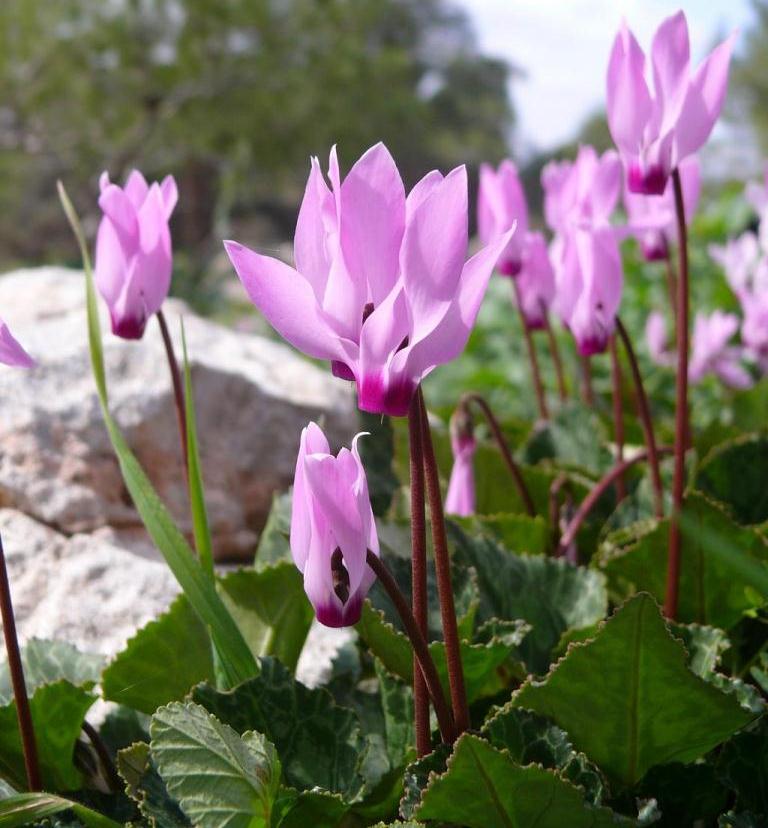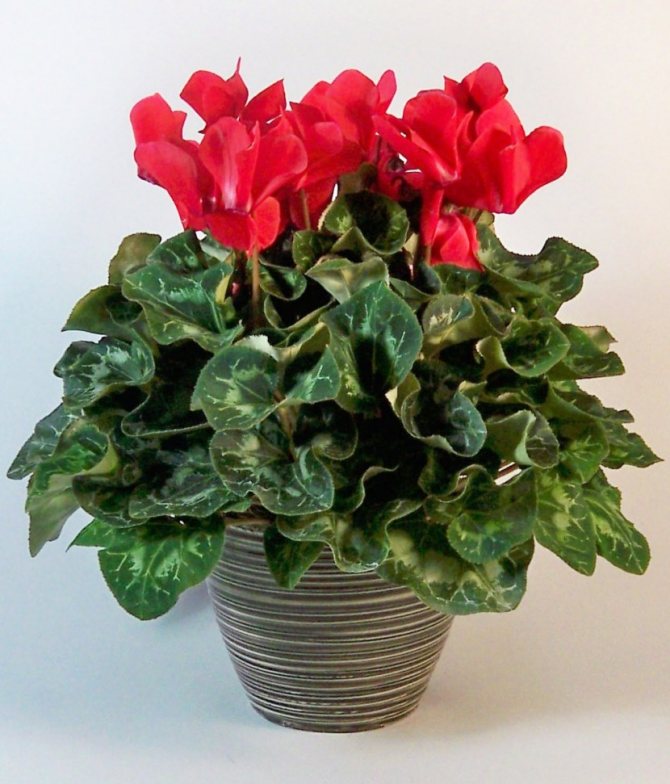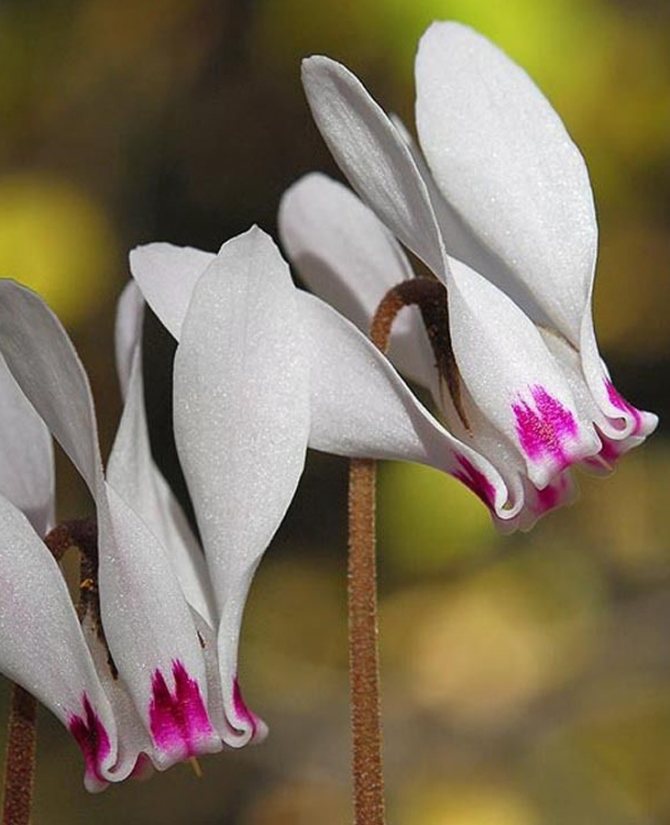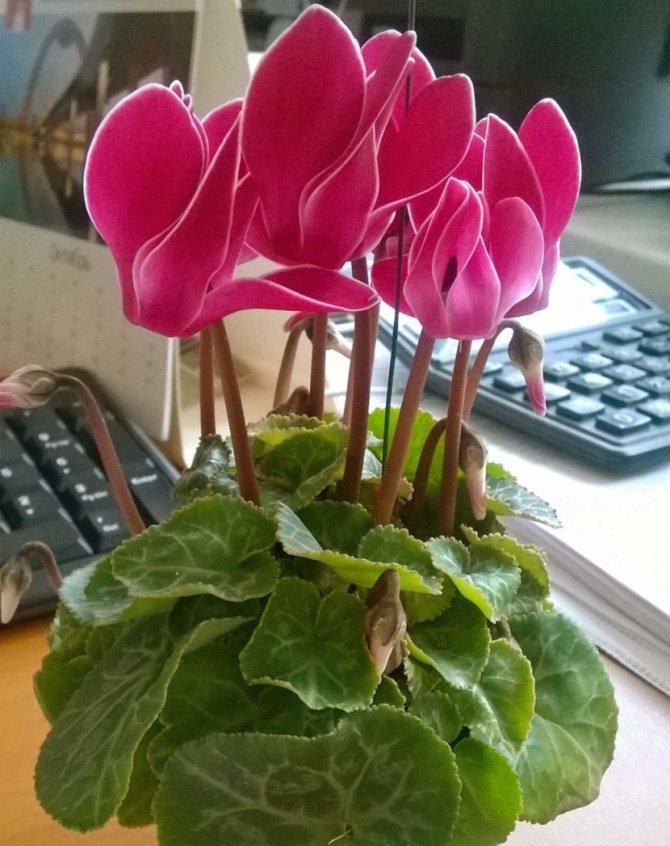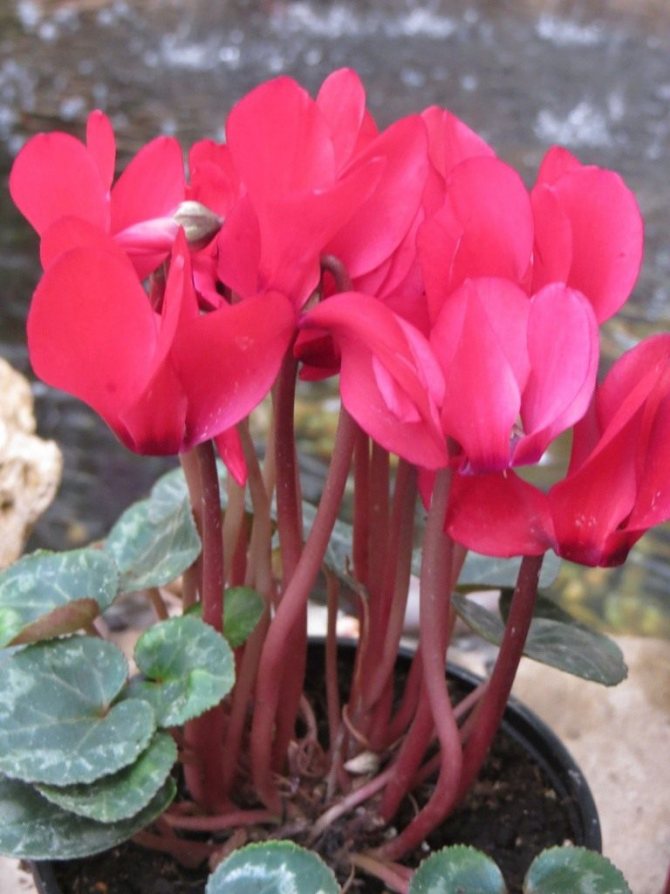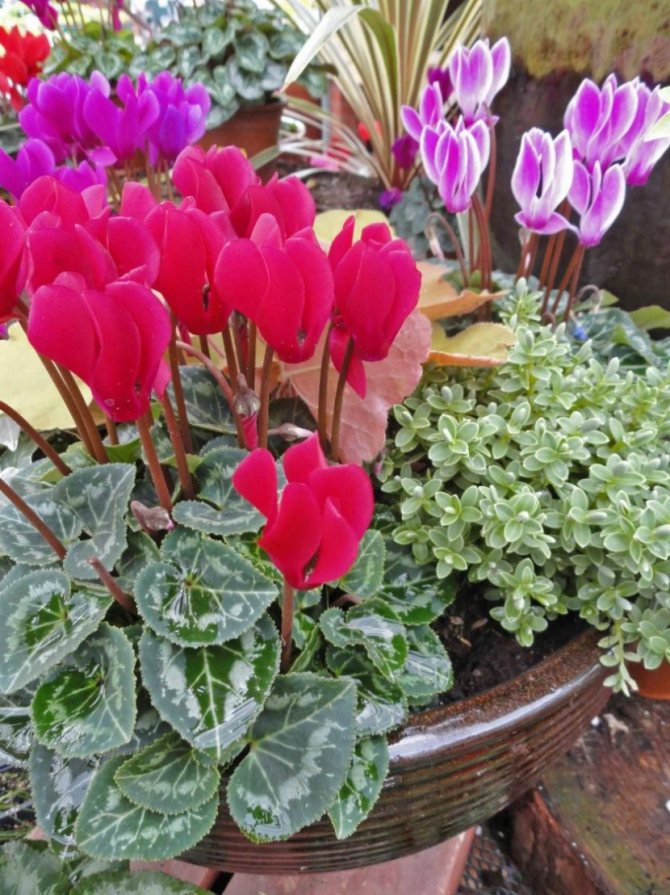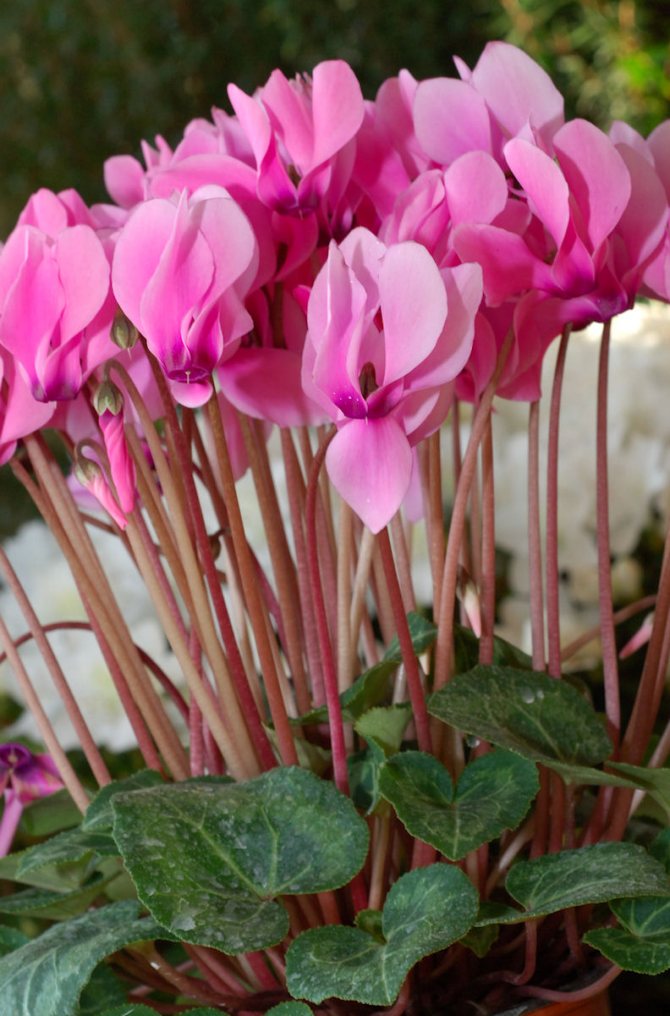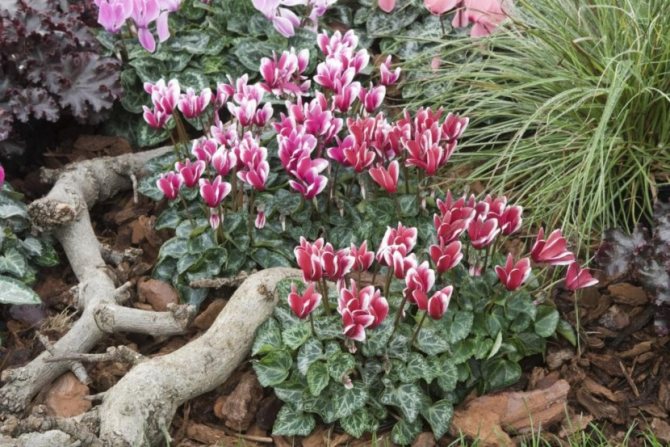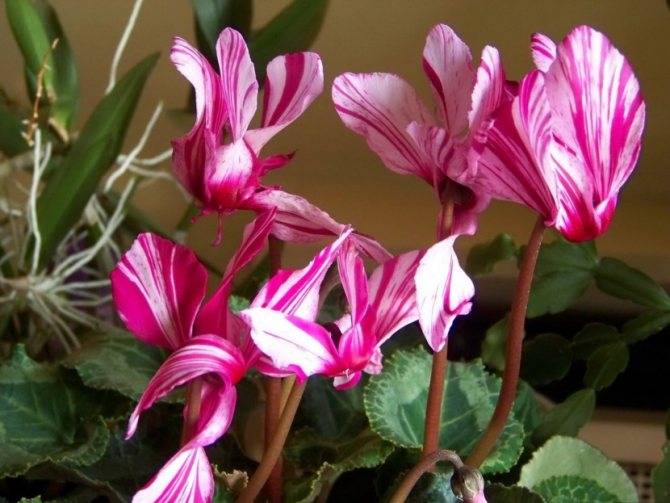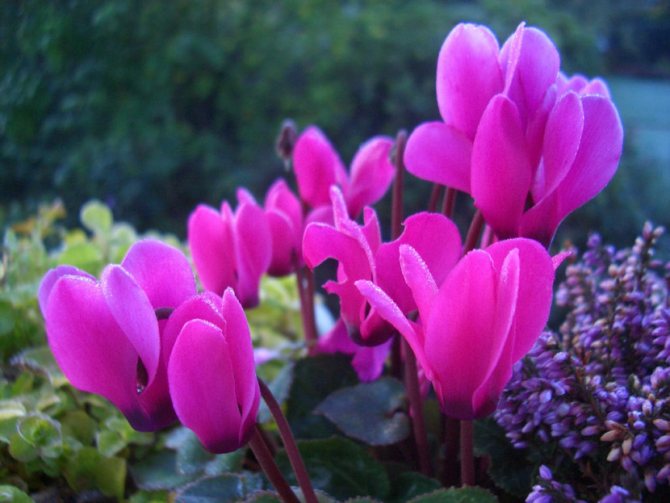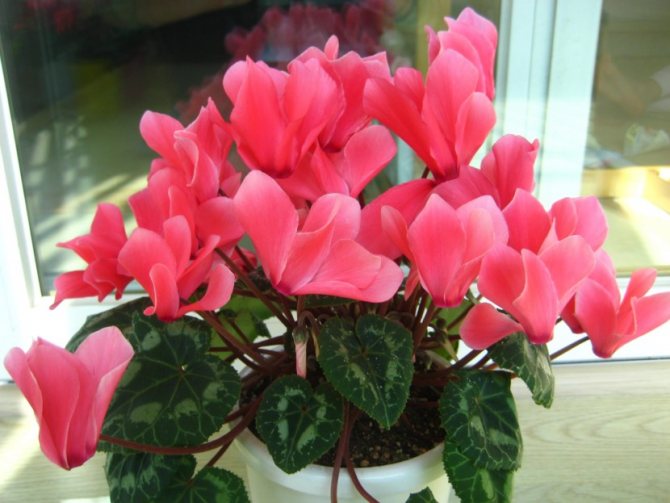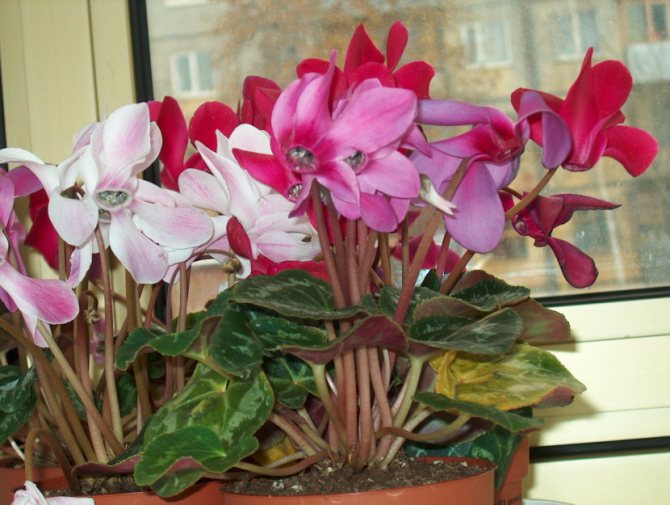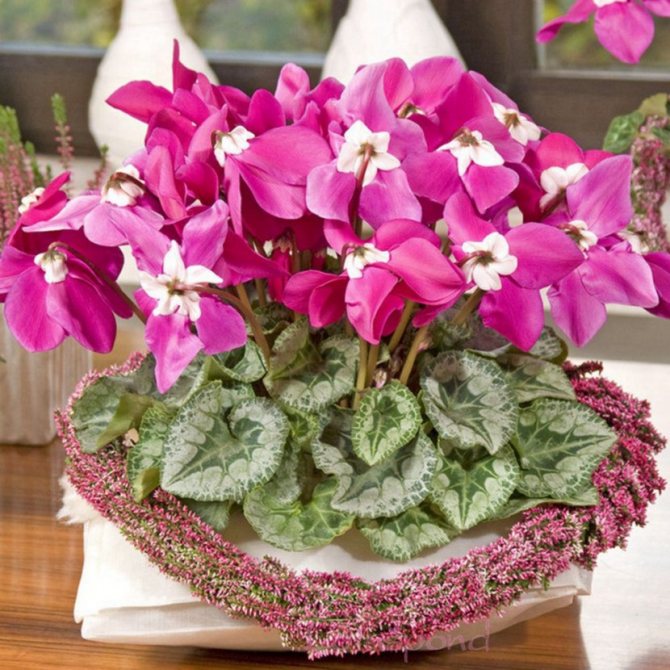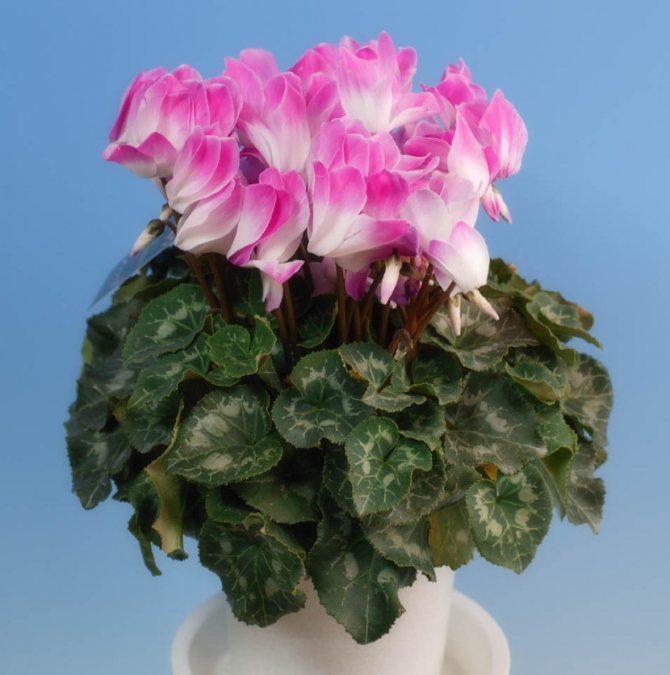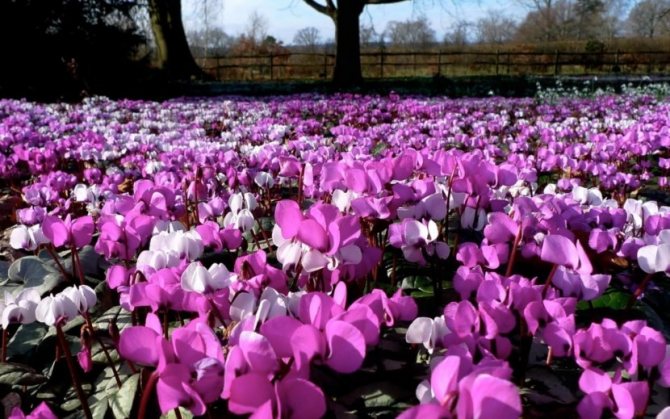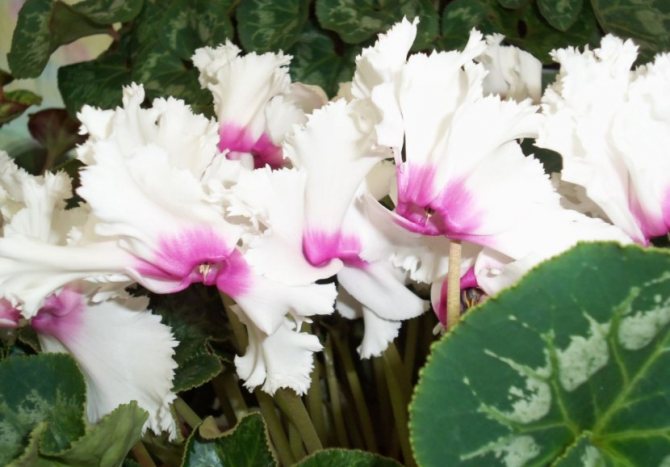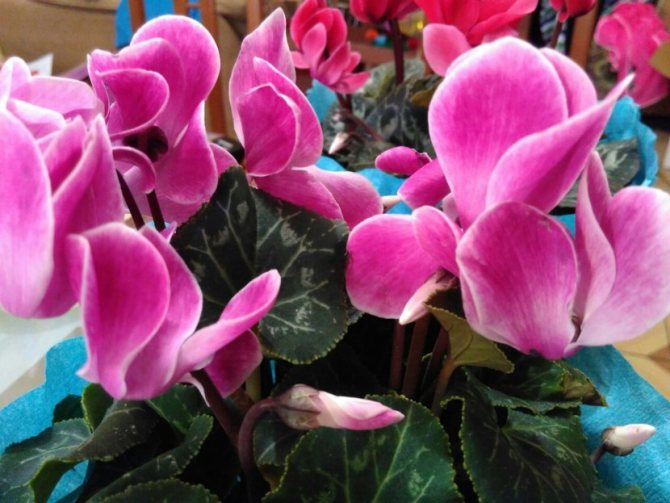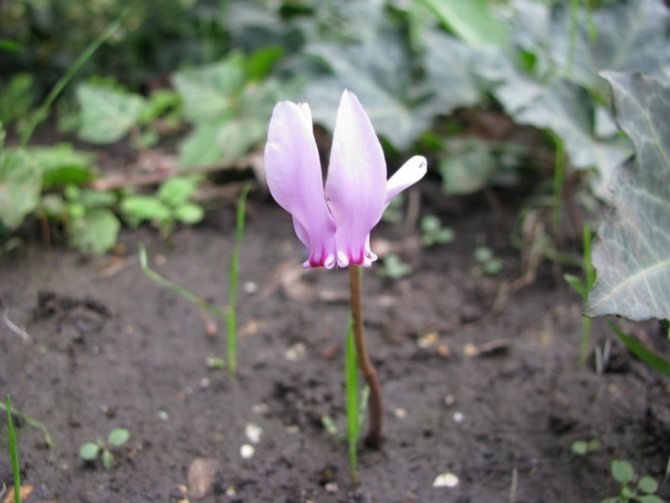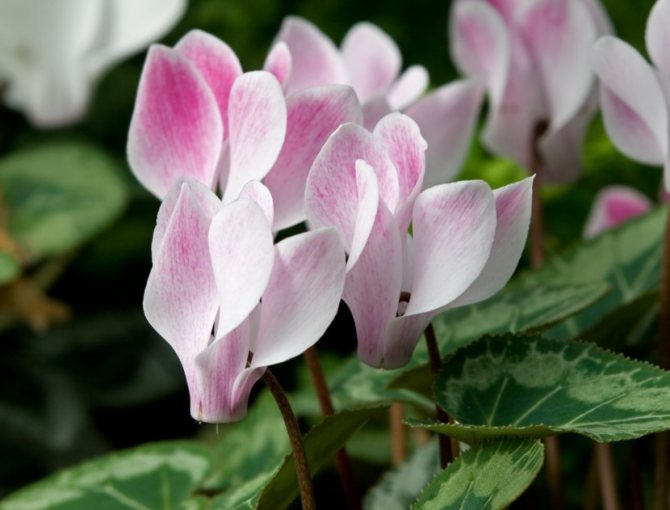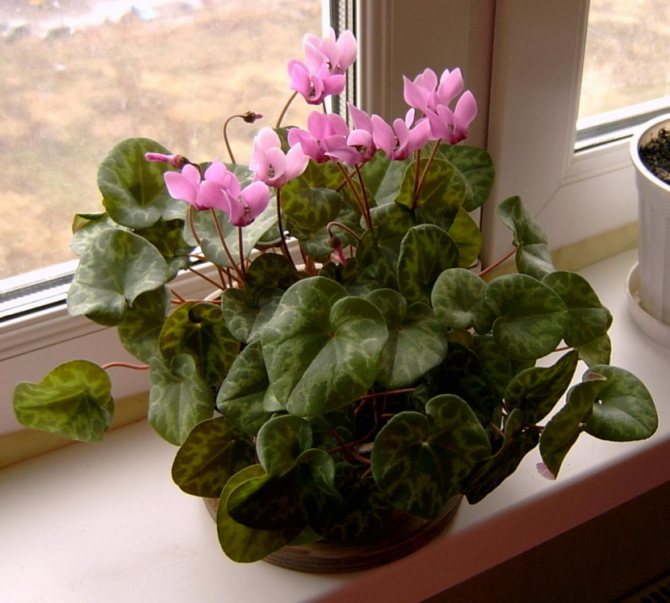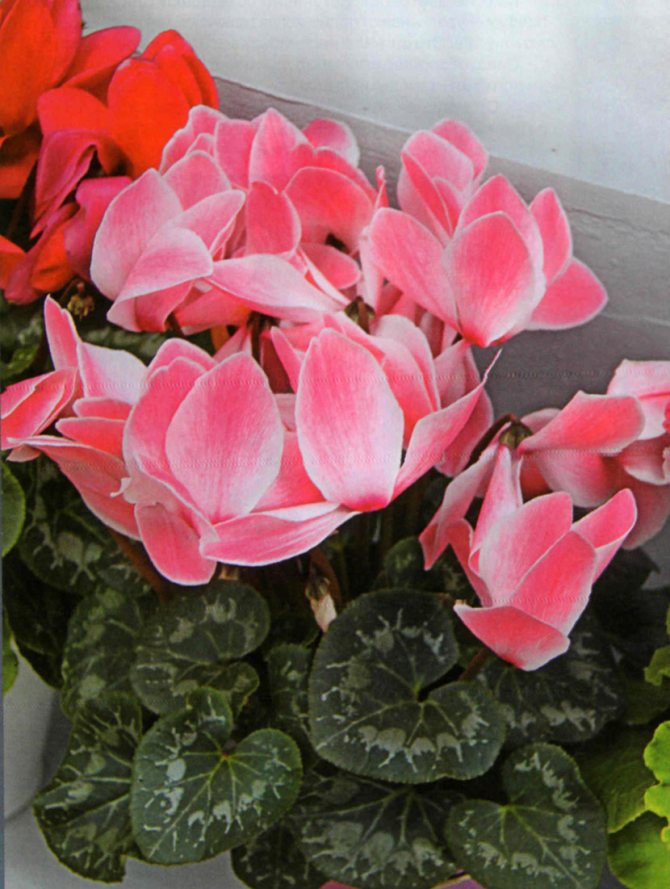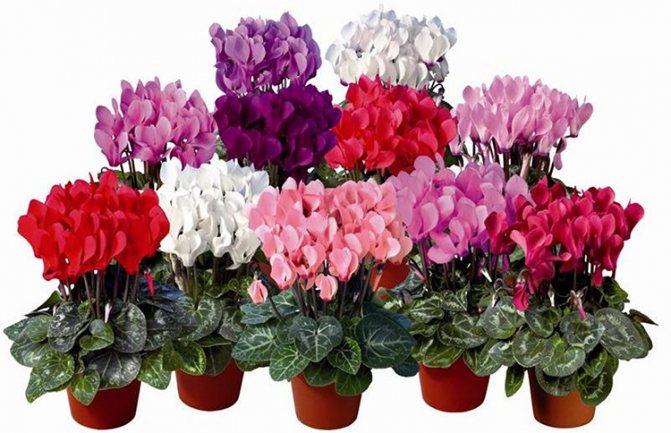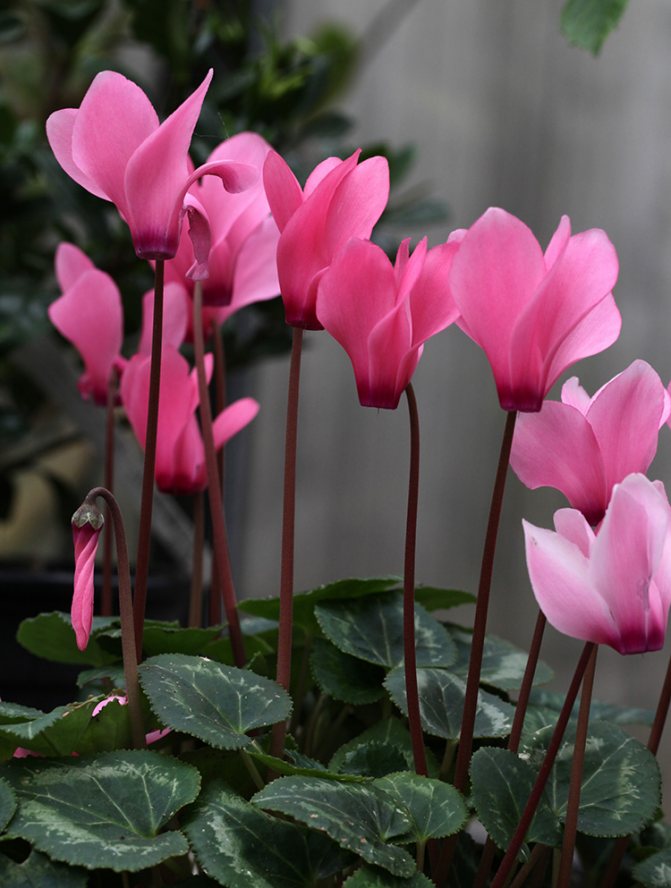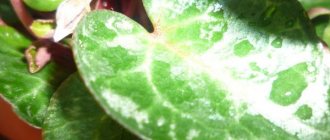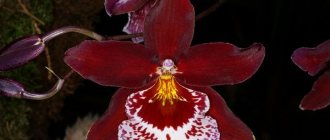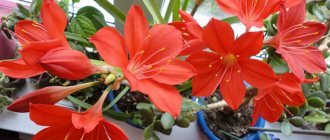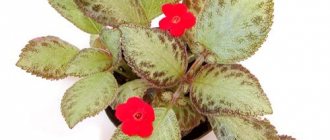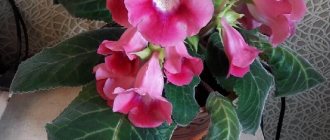The popularity of cyclamen - this lovely flowering plant - has only grown lately. In room culture, two types are more common than others: Persian cyclamen and European cyclamen. Both captivate with lovely original flowers. Persian cyclamen blooms in winter, when few plants please with bright flowering. How to care for a cyclamen at home - see our article.
Fresh articles about garden and vegetable garden
Pepper seedlings do not grow, stands still, what to do?
If the seedlings of cucumbers are very elongated, what to do?
Planting peas in spring sowing: when to sow, how to plant correctly?
Alpine violet (cyclamen) care after purchase
Alpine violets react sharply to changing habitats. The flower is a little withered during this period, the flowers fall, but this is normal if the care requirements are followed in the future.
Examine the flower first. If there are damaged leaves, peduncles, then carefully remove them with garden shears. Within a few days or immediately, the cyclamen must be transplanted.
Note! If you purchased the plant in a flowering state, postpone the transplant until the end of the dormant period.
For the first 3 weeks, place the plant in a secluded spot on the lighted side to prevent it from contracting the disease.
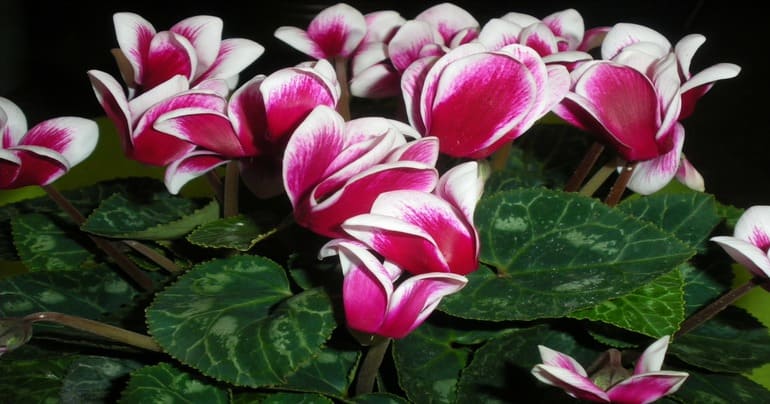
Purchase
If you decide to buy not a ready-made plant in a pot, but only its tuber, then ask the seller for its appearance and age, carefully examine it. It must have a weighty mass, be firm and resilient. See if the tuber has buds that are located at the top of it.
When buying a whole plant, also inspect it carefully from all angles. The leaves should not hang sluggishly, it is necessary that they be fresh. Persian cyclamen tuber is on the surface, it is smooth to the touch, without wrinkles. The plant is bought in October or November - at the beginning of flowering. Most buds should be unopened, in which case the flowers will last longer.
Growing conditions
At elevated temperatures during the humid season, the plant prepares for hibernation, therefore, it becomes problematic to take care of the plant during the heating season.
The state of the cyclamen depends on 3 indicators. Only by creating ideal conditions at these three points, you will enjoy abundant flowering for 20-30 years.
Temperature
In winter and autumn, the ideal temperature is 10-12 degrees Celsius, and in summer, at rest, it is from 16 to 20 degrees. Higher or lower rates result in shedding of foliage.
Important! If the alpine violet is grown in a greenhouse environment, create the same conditions at home.
Air humidity
Cyclamen needs high humidity - about 50%. Spray the plant daily as it grows. As soon as the alpine violet begins to bloom, stop this procedure before the plant begins to hibernate.
For a higher humidity indicator, it is recommended to create a water fog around the cyclamen, or put an aquarium, a container with water and pebbles nearby.
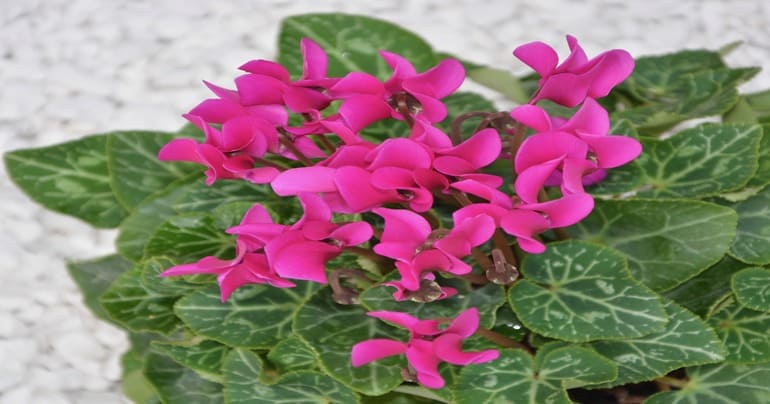

Lighting
Cyclamen is a light-loving plant, but it does not tolerate the rays of the scorching sun, so diffused lighting or partial shade would be ideal.
Choosing a place to put
The ideal place to grow a flower is a west or east window away from batteries. On the sunny side, the sun beats the leaves of the plant strongly, so additional darkening will be required. It is too cold on the north side in winter.
Photo of cyclamen at home
What does it look like in the interior?
Cyclamen flowers drooping, are located on long pedicels. After flowering, they twist in a spiral. The flower color is white, pink, orange and purple.
White flowers in glossy white pots are considered a winning option in the interior.
Mini cyclamens will fit well with a minimalist style. In this case, place the flowers in wicker baskets, buckets.
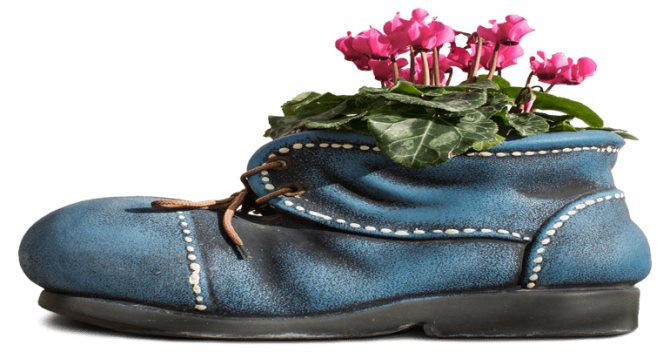

Bright purple or pink tones of cyclamen will perfectly fit into the interior with pine needles, Christmas decorations and candles. Choose shiny silver or gold pots for them.
The true stars of cyclamen are statute if you plant in groups. Choose the color depending on the color scheme of the interior.
Do not combine these flowers with other indoor plants - they look advantageous only with their relatives.
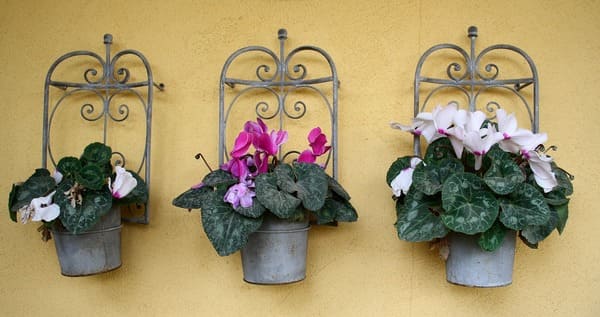

Flower features
Cyclamen, or alpine violet, is a herbaceous perennial of the Primroses family. It has been used in floriculture since the 16th century, but only from the second half of the 19th century began active work on the selection of garden and indoor varieties.
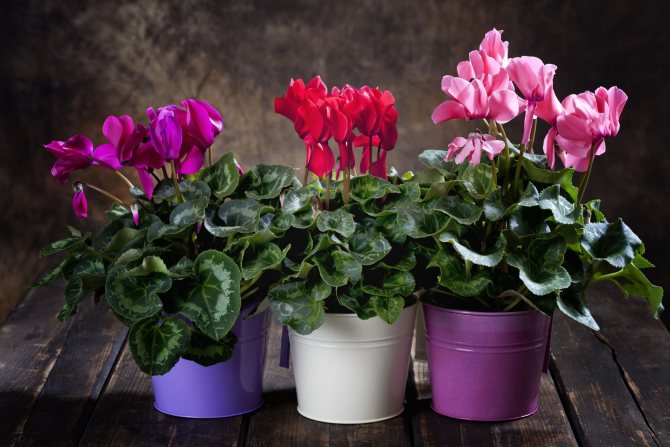

Petals can be painted in different shades
The flower has gained popularity due to the attractive shape and color of the leaves, combined with single bell-shaped flowers twisting around their axis. The petals can be colored purple, red, magenta, white or yellow. The buds are formed in winter or early spring, depending on the species, and remain fresh for up to several months. Cyclamen extract is used in medicine to create medicines for sinusitis.
The root is represented by a flattened round corm. It is it that contains useful substances used for the preparation of medicines.
Growing area
There are about 50 species in the cyclamen genus. In its natural environment, it is found in the Mediterranean, Northeast Africa, Iran, Turkey and Russia. The plant prefers mountainous terrain and bright glades, located far from water bodies, since moisture is detrimental to the tuberous root system.
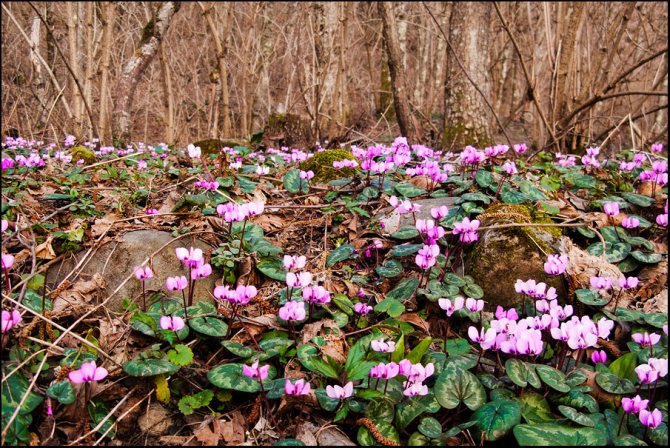

Cyclamen can be found in the forests and mountain heights of the southern regions of Russia
The specifics of growing in an apartment
Cyclamen is an unpretentious plant that even a beginner can handle growing. The tubers contain poisonous juice, so it is not recommended to place the container with the flower in apartments where there are active pets. When transplanting, you should follow simple safety rules - wear gloves, wash your hands with soap and water after work.
Interior use
Almost all varieties of cyclamen are used as a house pot plant; planting in open ground is not recommended. The plant is suitable for creating group flowering compositions, undersized varieties fit into minimalistic interior design. The advantage of this culture is winter and early spring flowering, when most of the plants are still dormant.
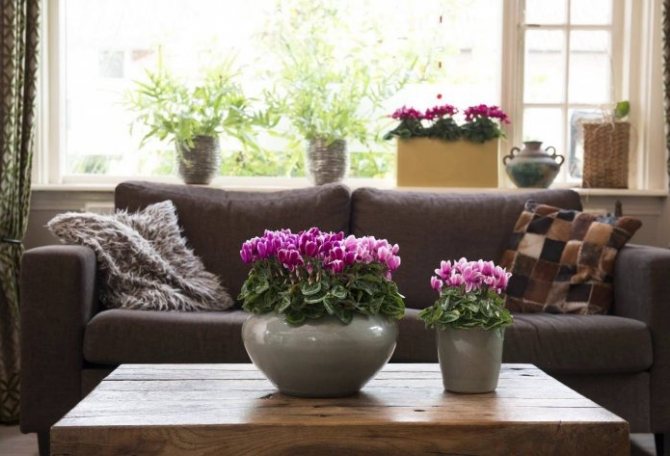

The plant fits perfectly into the minimalist style of the interior.
Flowering conditions
Alpine violet is divided into 2 types, each of which has its own flowering time:
- Persian dryak - from the beginning of October to the end of January.
- European Dryak - from mid-December to late April.
For the plant to bloom, keep the temperature between 10 and 14 degrees Celsius, and also keep it away from the battery.
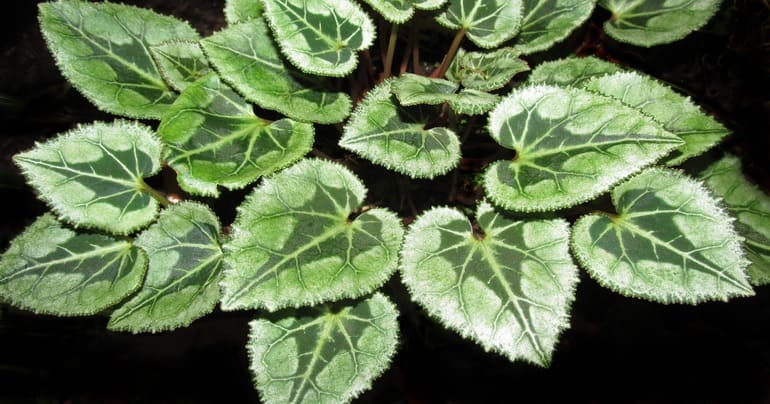

Cyclamen flower: species and varieties
Breeders have developed hybrids for home and garden breeding: heat-loving and frost-resistant, with smooth and double petals. Cyclamens are represented by thirty species and dozens of varieties. Growing and caring for hybrids and varieties at home has some nuances.
Cyclamen Persian
From October to May, when many flowers are resting, the Persian cyclamen admires with its bright flowering.
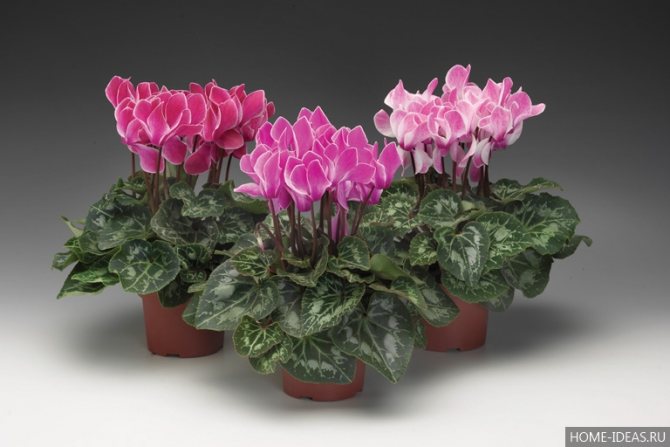

The jagged-edged leaves are laced with a network of marble veins. Fragrant flowers: white, pink, red - gracefully extended on slender peduncles. Persian cyclamen is slightly capricious. Home care consists for him in high humidity, frequent spraying, dressing, keeping in a cool room.
Advice: you should place the flower on the windowsill on the east side, do not allow drafts and hot air flows from the central heating batteries.
Cyclamen european
For flower growers who first decided on a close acquaintance with cyclamen, it is worth recommending the European cyclamen, which came to us from Europe.
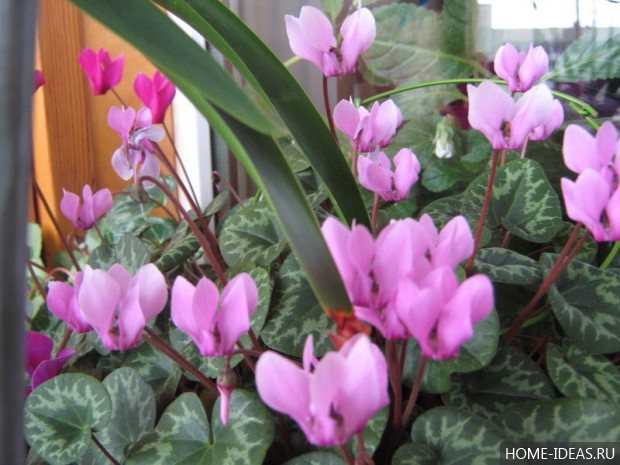

It is modest and unassuming, does not require daily attention, blooms from April to November. Numerous pink or pale purple flowers, swaying on long peduncles, exude a delicate aroma. Feels great not only in indoor conditions, but also in the garden. If we compare the European and Persian cyclamen, the differences in the photo in appearance are almost imperceptible: the European variety has a slightly smaller flower size, but the "European" does not bloom so abundantly. The main difference is the flowering time.
Rare types of cyclamen
Cyclamen kosky blooms in early spring or winter. Glossy heart-shaped leaves, single large snow-white, pale pink, red or dark purple single large flowers. Homeland - the warm coast of the Black, Mediterranean and Aegean Seas. Partial shade is preferred for successful cultivation.
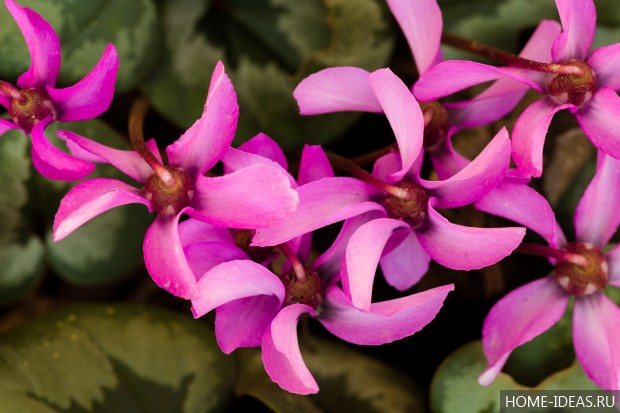

Cyclamen Caucasian blooms at the end of winter and pleases with flowering from late winter to April. The color of the petals is varied: from pastel colors to bright and saturated. Homeland - the high-mountainous eastern part of the Black Sea coast (from Crimea to Northern Iran). When grown indoors, it especially needs a drained substrate.
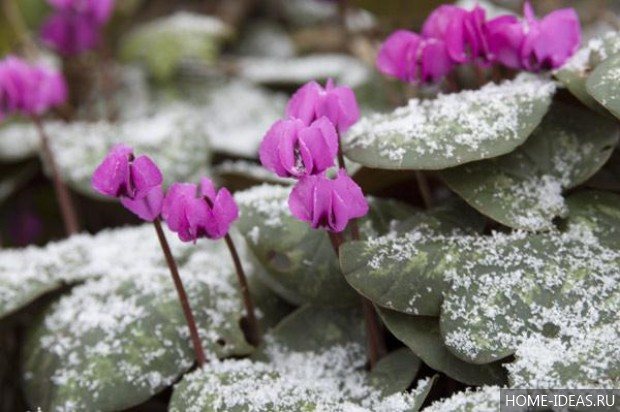

Leaving during flowering
The main care during flowering consists of the following actions:
- Don't spray the flower.
- Try to ventilate the area daily.
- Feed with fertilizers for flowering plants, or mineral complexes once every 2 weeks. Fertilize only as directed on the package.
- For abundant flowering, moisturize around the pot.
- Do not place near heating appliances.
- Water as the soil dries, 3-4 times a week. Better to infuse water for 3-4 hours. Its temperature should be no higher than 14 degrees Celsius. The best option is to water through the pallet.
- Do not transplant plants under any circumstances.
Correct care
The basis for proper care of cyclamen is watering. So, in winter, watering should be minimized and spraying should be drastically reduced. In the summer, you need to spray not the flower itself, but the air, because water can harm the buds or leaves of the plant.
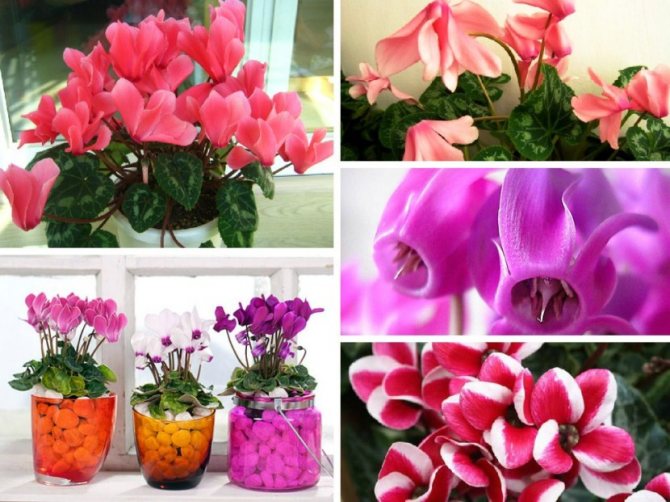

Since in the summer the tubers protrude from the ground, they are categorically contraindicated in excess moisture, which can lead to decay.
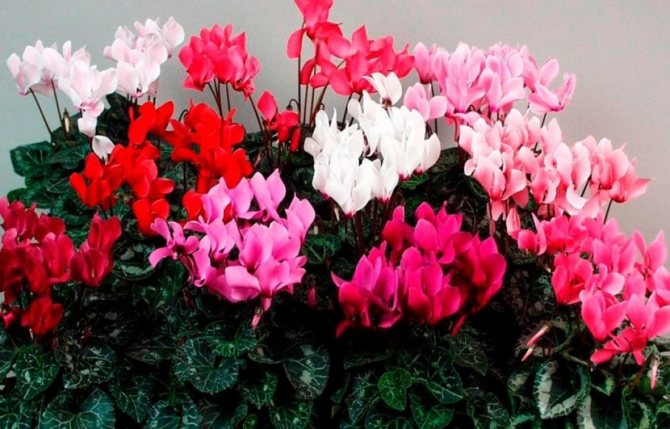

The ideal summer watering option is to place the pot on a pallet of damp expanded clay. However, drying out the soil is no less harmful than waterlogging, especially during the flowering period.
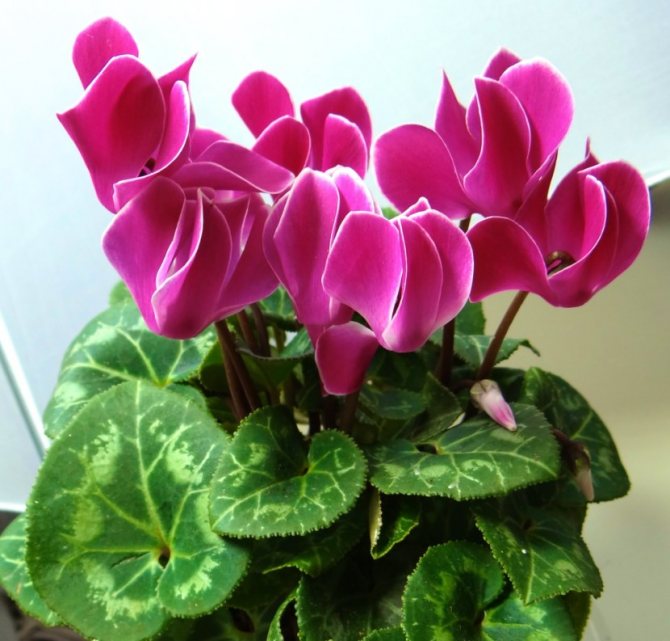

For traditional watering, it is best to direct the water jet around the edges of the pot to prevent moisture from damaging the tubers. When watering, water that has been settled for at least 12 hours is used.
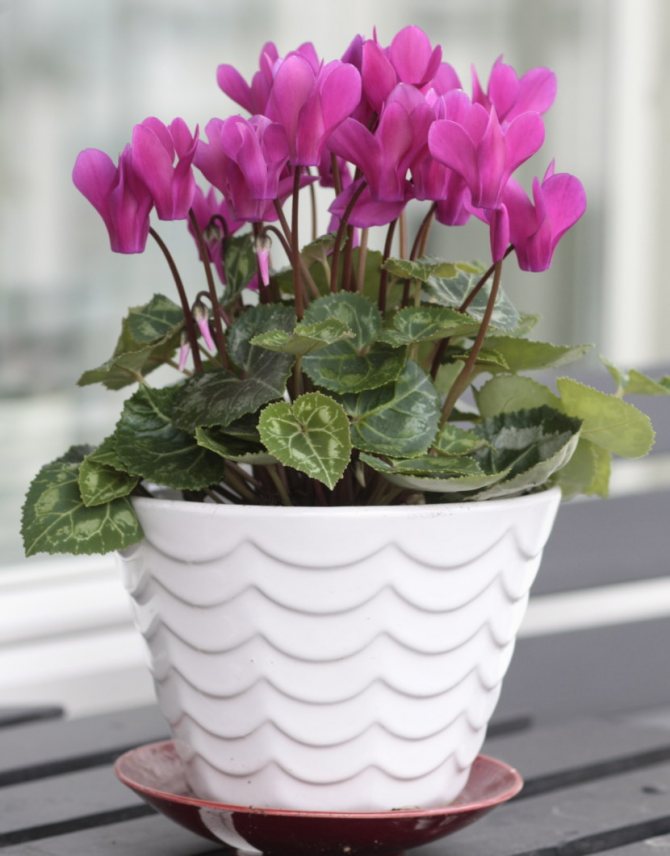

Experts recommend fertilizing only during the flowering period.
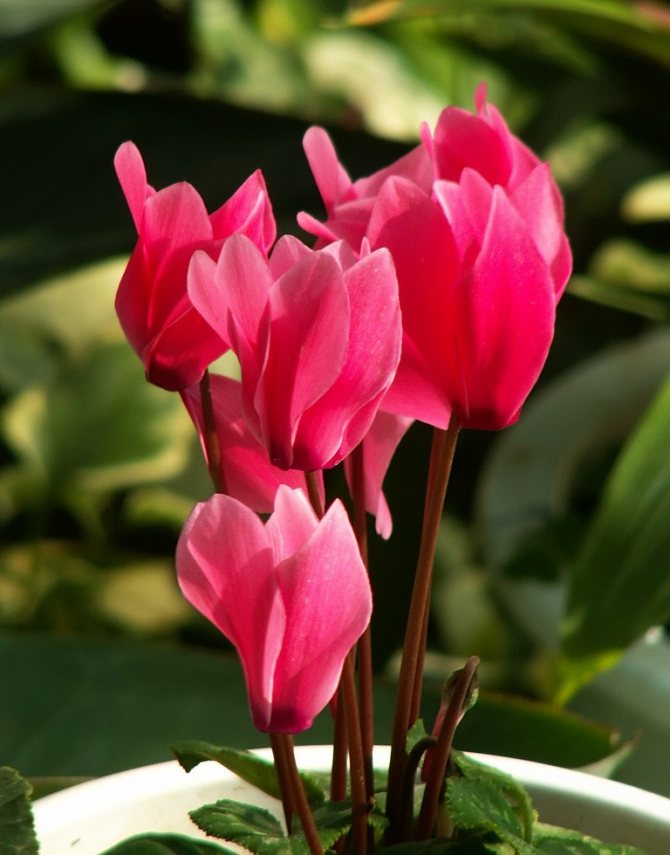

It is best to use liquid-based fertilizers, the solution should have a weak (50% of the specified in the instructions) concentration. You need to fertilize the flower no more than once a month.
Does a flower need a dormant period?
If you follow the rules of care, you can slightly extend the flowering of the alpine violet, but you will not be able to completely get rid of the dormant period. After all, it is necessary so that cyclamen can have a good rest and gain nutrients.
Interesting fact! Young cyclamens may not go into hibernation at all and bloom all year round, but over time, their regime returns to normal.
The resting phase of the varieties is as follows:
- In the Persian cyclamen, it starts from the beginning of spring and lasts until the end of September.
- In the European - from summer to late autumn.
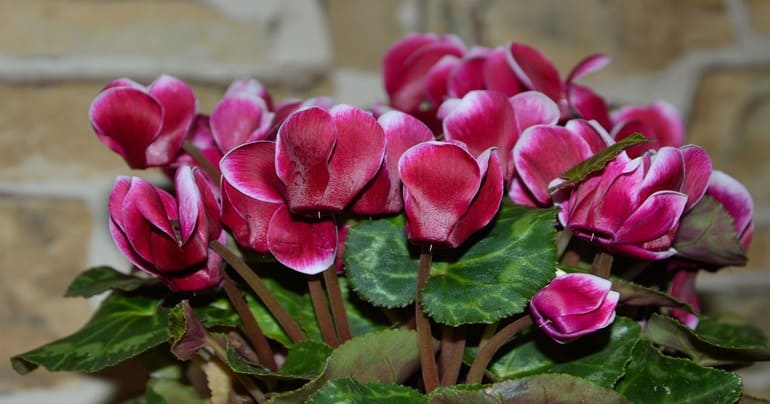

Varieties
Currently, 20 varieties of cyclamen are known, however, the most common among domestic florists are the Persian variety of cyclamen and the European species.
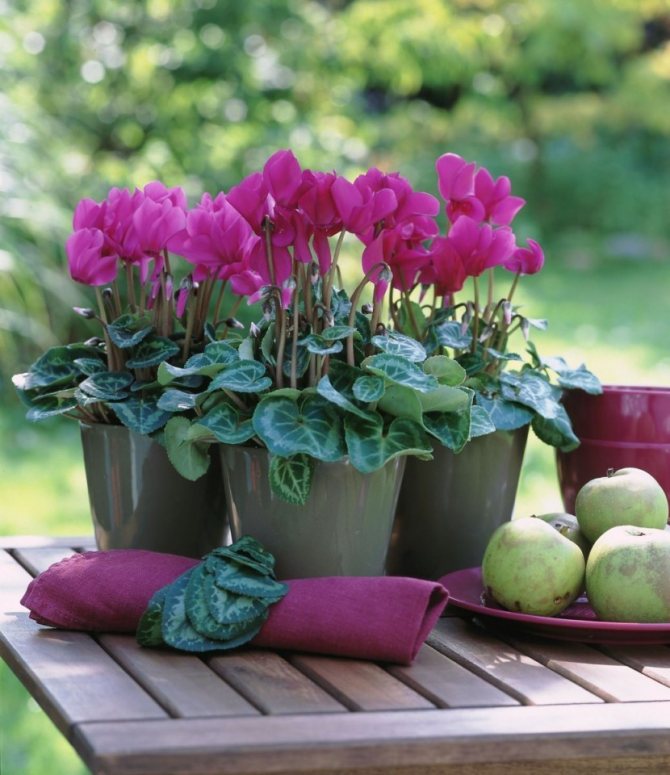

A characteristic feature of the Persian variety is the almost constant flowering of the plant, and the European cyclamen blooms less at home, however, thanks to the beautiful heart-shaped leaf shape, it also found its fans.
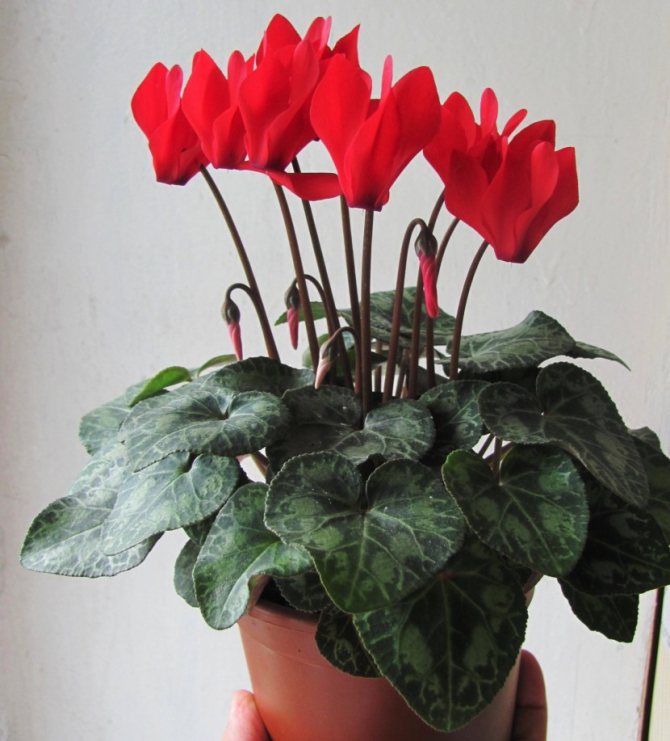

Often the Persian cyclamen is called the alpine violet. This is a rather large indoor flower, reaching 30 cm in height. This species is characterized by large buds of purple, white or pink. The flowering period begins in the fall and ends in the spring; in the summer, the flower rests.
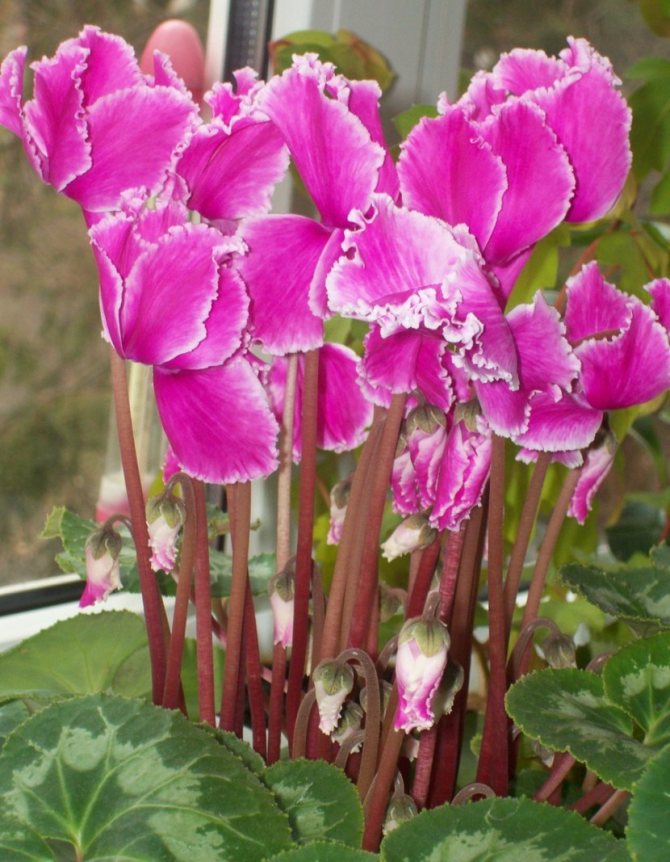

The European cyclamen is characterized by the presence of beautiful green leaves all year round. The buds of this variety are smaller, painted in a pale pink hue and have a very delicate aroma.
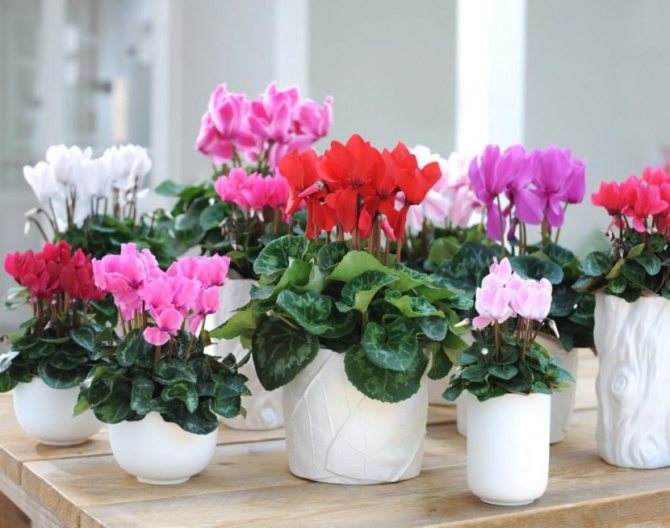

Growing cyclamen of this variety is not difficult, therefore experts recommend it to all novice growers.
Features of the content of different varieties
Such varieties as Aneli, Garda, Elbum belong to the European species. They are more hardy, better tolerate normal room temperature. They like cool air more, so take them out to the balcony or garden in the summer.
European varieties strongly hate the scorching rays of the sun and tolerate diseases worse. Fertilize plants during flowering no more than 1 time in a week and a half.
Persian cyclamen varieties such as Mini Aneli, Dark Red, Leela love humidity from 50% and feel bad if it is not. It costs no less than 1 time per 2 weeks to apply fertilizer.
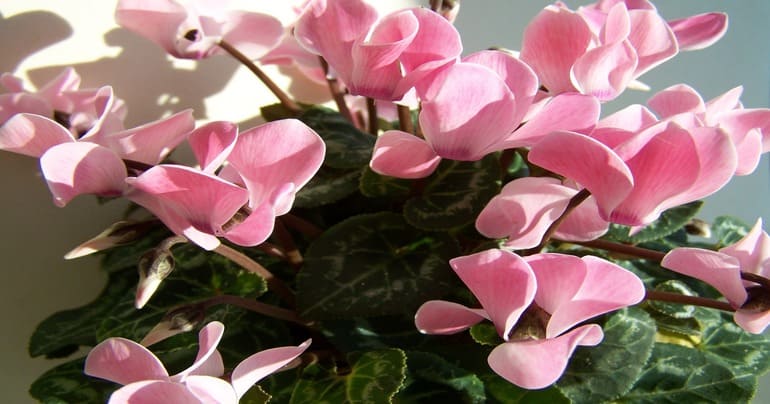

Pest and disease control
Like any other plants living at home, cyclomenia will not hurt or will be attacked by pestsif the care is done correctly and thoroughly. However, the following troubles can be expected:
- Of the pests, the most terrible insect is the cyclamen mite. When the enemy attacked, the leaves of the cyclamen acquire rigidity, the edges curl up, and a gray coating resembling dust becomes visible on the reverse side. Leaves begin to fall off or become lethargic and lifeless. The buds are also affected. The cyclamen mite is very small and inconspicuous. The plant will be helped by the drug Agravertin or another remedy against parasites - Fitoverm. Processing is carried out twice every 10 days. The experience of flower growers shows that it is effective to deal with it only at the initial stages of the lesion, but if time is lost, it is not possible to save the plant.
- Other pests can also be unwanted guests. So, cyclamen love thrips, aphids, spider mites, but they are not as scary as the previous attacker. With them, the troubles are not so fatal.
- Among the diseases, there is a sooty fungus that occurs after the invasion of aphids. The plant can get sick with late blight rot, anthracnose.
Delicate, unusual and spectacular flowers of cyclamen grown at home with careful care and attention, able to create a joyful atmosphere in the house... We especially need positive emotions in winter, when there are so few sunny days. At this time, most types of cyclamen are in bloom, and today we learned how to care for it.
Transfer
The new transplant pot should be larger than the previous one and have drainage holes. The soil for transplanting is bought, or prepared independently according to the recipe:
- ½ Humus and sand.
- ½ Sod or deciduous soil.
The transplant is performed in 6 stages:
- The cyclamen is removed from the container along with the earth.
- The root is shaken off, washed under cool water.
- Inspect for damage, rot and mold on the tuber. If there are damaged areas, they are cut off, and the cut points are sprinkled with crushed coal.
- The finished mixture is poured into a pot by 1/3.
- Insert the plant, cover it to the edges of the pot.
- Water the soil, spray the leaves.
The transplant is performed every 4-5 years. The best time is the beginning of March.
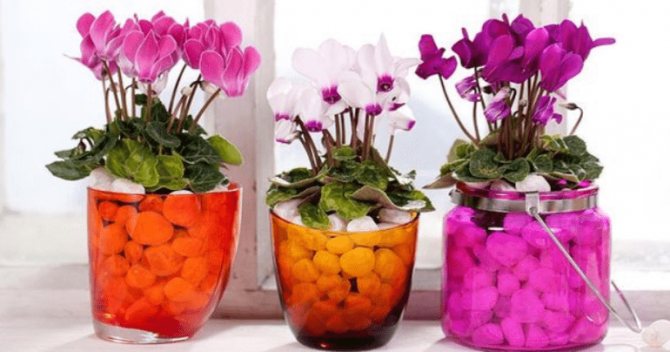

Reproduction methods
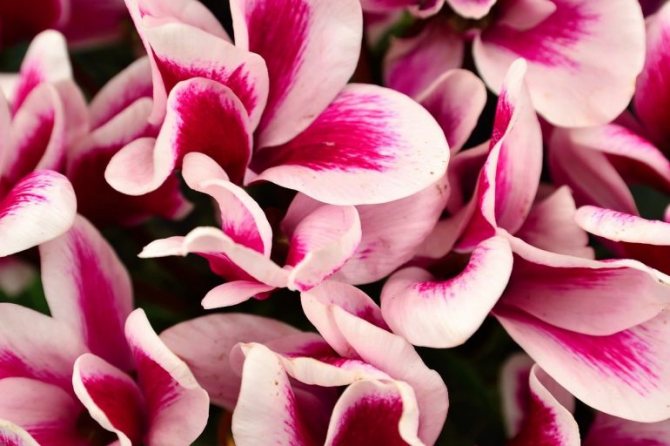

Photo: https://enn.imadeself.com/photos/cyclamen-flower-pink-nature-flora-233543/
There are two ways to get new plants - tubers and seeds. The first one is used exclusively at home, it is simple and does not require much effort. The second is mainly used for scientific and commercial purposes. Breeders thus develop new varieties, and flower growers grow cyclamens in large quantities for sale. This method is quite time consuming.
Tubers
When dormant, dig the tuber out of the pot and cut it into several pieces. You can get as many as there are growth points.
The sections are slightly dried in the fresh air, and then treated with a growth stimulant and disinfected with activated carbon or ash. Unfortunately, this does not always help, and the tuber can rot due to an ingested fungal infection, to which cyclamens are very prone.
Pieces of tuber are planted each in their own pot. If you are lucky and the cyclamen does not die, then in the fall you can wait for the first leaves.
Seeds
It is quite difficult to grow cyclamen from seeds at home, this process is time consuming and requires accuracy. The best seeding time is May and June.
The seeds are planted in deciduous-heather soil and the container is covered with foil or glass. This creates a greenhouse effect with constant humidity and temperature. Place the container on a warm sunny windowsill, but avoid direct rays - the light should be diffused. The ideal temperature for germinating sprouts is 18-20 ° C. Moisten the soil regularly by temporarily removing the glass for ventilation. If all conditions are met, the first shoots will appear in three to four weeks.
After the seedlings get stronger and acquire two leaves, and this will happen no earlier than in a couple of months, they are dived, that is, transplanted at a distance of several centimeters from each other. In this case, the soil should be changed to peat or use the same deciduous-heather, but fresh.
Further care of young plants does not change - the same greenhouse effect and a temperature of about twenty degrees. The soil is regularly moistened, but not allowed to overflow. The light should be diffused, slightly shaded. Twice a day, the sprouts are sprayed from a spray bottle, at the same time airing is carried out.
The second time seedlings dive when they already have four leaves. This usually happens in mid-September. The distance between the planted plants should be already six to seven centimeters.
In winter, young cyclamens are provided with a temperature of + 10-12 ° C, moderate watering and spraying only on sunny days. Without fail, the soil is loosened to ensure air exchange.
The third dive falls on the month of January. Seedlings are placed even further apart - eight to ten centimeters. And only in March, the young are transplanted each into a separate pot.The pot is chosen small, up to 10 cm in diameter, and the ratio of width to height should be 1: 0.6, that is, ten in width and six in height. A little sod land mixed with wood shavings is added to the deciduous-heather soil. The amount of additives should not exceed one fifth of the total volume of the pot.
The temperature in the greenhouse rises to 22 ° C. From this moment, the active growth of the plant begins, the foliage goes beyond the pot, so the cyclamens are placed further so that they do not interfere with each other. Without fail, they are shaded from the bright sun and sprayed at least four times a day.
To get strong and strong plants, cyclamens are transplanted at least three more times, each time in a pot several centimeters larger than the previous one. The first time this is done in May, then in June and at the end of July. Moreover, in the first two cases, it is necessary to make top dressing for cyclamens, and in the latter it is not required.
When replanting in May, make sure that the substrate is very loose. On subsequent ones, it should be of medium density. In June, the tubers are freed from the land by only a third, and in July - already half. If this is not done, then there is a risk of decay in the autumn-winter months.
Landing
The plant is recommended to be planted in August-September. Plant the seeds or shoots between themselves at a distance of 2-3 cm from each other. Make the furrow 1 cm deep.
It is better to prepare the substrate for planting yourself from the following ingredients:
- Leafy land.
- Peat.
- Coarse sand.
- Humus.
The land brought from the garden, vegetable garden requires disinfection. They put it in the oven or pour it over with boiling water. Holes are made at the bottom of the planting box so that excess moisture comes out.
Before planting on the bottom of the container, a drainage layer of expanded clay 2-3 cm is laid.
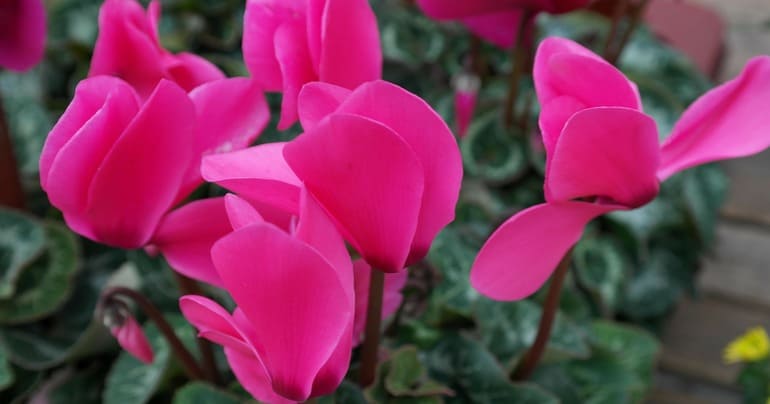

How to grow cyclamen from seeds
If buying a ready-made potted flower does not appeal to you, you are interested in going through this whole process yourself, then try to purchase high-quality seeds. Of course, you can select planting material from existing flowers, but you will have to first carry out the pollination process (with a brush or cotton swab). Pollination must be done repeatedly, from flower to flower, while the presence of different varieties is only welcome. When the plant has faded and the seed pods are ripe, pick them off without waiting for cracking. Wrap the pods with a clean cloth or paper and when dry, they will open by themselves - this way the seeds will be preserved.
Select a suitable soil for sowing seeds. The substrates sold in flower shops are also fine. Such soil most often contains peat, leafy soil, vermiculite. If you want to make such a substrate yourself, then you just have to mix equal proportional parts of these components. Do not forget about drainage (large foam balls or small crushed stone), there must be holes at the bottom of the container.
The two most commonly used methods of sowing seeds are:
- The seed is pre-soaked in cold water (for two or three days), to which a couple of drops of dish detergent should be added every day. This water should be changed daily and its temperature should be quite low.
- The second option is more familiar to flower growers and gardeners - pre-treatment (soaking) with a slightly boron solution of potassium permanganate or with Epin (2 drops per 200 ml of water). For seeds, 15 hours of such a "bath" is enough; after such treatment, even the old seed material gets a "shake-up" and sprouts.
Reproduction
Cyclamen is grown from seeds, daughter shoots and tuber division.
The first option is more reliable - the germination rate is 80%. The seeds are pre-soaked in a stimulator for 18 hours. Planted in an opaque container with a substrate.
In the second case, the daughter processes are torn off and planted in moist soil. Cover the outlet with a bottle for 2-3 weeks.
Method 3 involves dividing the bulb in half and planting them in a substrate. The planting material is taken out of the ground and dried well. Each divided area should have one bud and roots.
Cyclamen flower - photo and brief botanical information
Until now, the disputes about which family should be attributed to the herbaceous perennial - to the Mirsinovs or Primroses - have not subsided. The distribution of the genus cyclamen in nature is concentrated in the warm climate of the Mediterranean countries, Northeast Africa and Turkey. There is also a popular name for dryakva.
The variety of colors of cyclamen in nature:
In the southern part of Europe, this plant is also found, which is nicknamed the alpine violet.
This tuberous plant is small and does not take up much space either in nature or in a pot on a windowsill. The wide leaves are patterned and rounded in shape, with some fringe. Small or large flowers rise above the leaves in a slender row. The color of the flowers is very diverse.
If you decide to acquire a cyclamen at home, then it should be borne in mind that this is an ephemeroid: after the growing season and flowering, only bare soil in a pot will delight you, while the next life cycle will pass under the ground in the tuber.
Rejuvenation
Cyclamen is constantly growing. Every year, young leaves appear, and the old ones die off. As a result, dry tree-like trunks are formed, which noticeably spoil its appearance. This is where plant rejuvenation is required. Many owners are afraid of this process, but in reality it is simple:
- Grasp the trunk of the flower with all your strength.
- Unscrew the cyclamen at the base with a sharp motion so that the tuber remains intact.
The hardest part will be leaving. Now water the cyclamen just a little every day. It is necessary to put the pot in a cool place with diffused light. A month later, a new shoot will appear on the tuber.
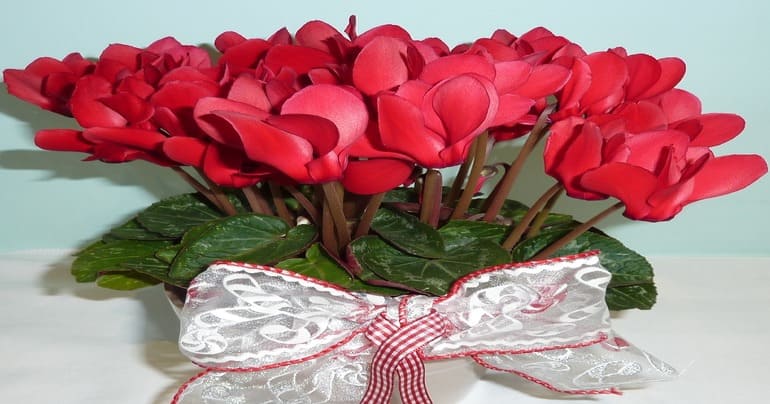

Cyclamen problems
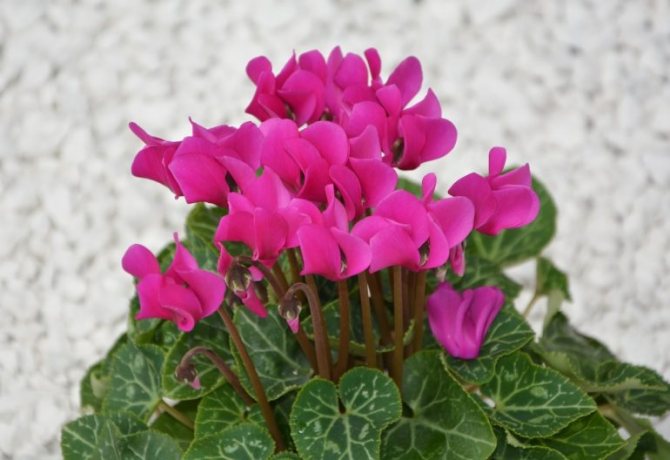

Photo: https://enn.imadeself.com/photos/flower-cyclamen-mini-bright-pink-2685575/
Alpine violet can give a novice florist a lot of difficulties and headaches. Either she drops the leaves, then refuses to bloom, then some other attack will happen. If you are new to the cultivation of indoor flowers and are not familiar with the peculiarities of cyclamen, then this cheat sheet will help you make the correct "diagnosis" and adjust the care.
| Problem | Reason and solution |
| Brown spots on the leaves. | There is not enough moisture in the air. Spray more frequently, or place the pot in a drip pan of wet claydite. The same problem can occur due to too bright sunlight, direct rays hitting the leaves, causing burns. Move the pot to a more suitable place or shade it. |
| Cyclamen dropped the already formed buds. | Failure to comply with the temperature regime. Most likely the flower has become hot. |
| Poor flowering. | The pot is probably too big. The plant is busy “capturing” a new territory and growing its root mass. He has no time to be distracted by the formation of buds. |
| The leaves turn yellow and wither. | If this happens after the end of flowering, then this is a normal phenomenon - the flower is preparing for a dormant period. In other cases, excessive watering was most likely to blame. Rotting has begun - the plant needs to be urgently saved. Remove the tuber from the pot and remove any damaged parts of the root system. Treat the sections with ash or activated carbon. Plant the flower in a new medium. Take care of proper watering. |
| Cyclamen does not bloom. | The apartment is too warm. The optimum temperature for setting buds and flowering is + 15 ° C. |
Watering
Water the cyclamen when you see the topsoil is dry. You can check dryness with your finger - just release it into the ground until the phalanx is immersed. For insecure gardeners, a moisture indicator is suitable.The frequency of watering depends on the condition in which the cyclamen arrives. A young plant is watered more often. Alpine violet at rest does not require much moisture.
The water temperature should be no more than room temperature. Desirable - 2-3 degrees lower.
For settling, take tap water and stir in a wide-necked vessel. It is not necessary to close the vessel. Boiled water is not bad at all, but it will not benefit the plant either. Some experienced gardeners use melt water.
Medicinal properties and contraindications
Since ancient times, cyclamens have been used for medicinal purposes. With their help, purulent skin diseases and boils were treated. Back in the sixteenth century, attempts were made to induce childbirth and intensify contractions. And the ear-shaped shape of the leaves gave hope that the plant could treat otitis media.
Currently, the plant extract is part of such a well-known drug as Sinuforte. It is used in pharmacology for the manufacture of antiseptic, anti-inflammatory, antiparasitic, and also antimicrobial agents.
The sap of the plant can be harmful if used incorrectly and in excess of the dosage. Therefore, refrain from traditional methods of treatment with cyclamen. It is strictly forbidden to give it to children, expectant and nursing mothers, allergy sufferers.
If animals live in your house, especially cats that walk by themselves and can easily get on the windowsill, then you should know that cyclamens are poisonous for four-legged pets.
Top dressing
Fertilizers for flowering plants with a complex of all necessary substances are suitable for cyclamen. Feed according to the instructions on the package. During rest, fertilize the alpine violet is not worth it. It is impossible to increase the frequency of feeding, you can only decrease it.
Important! Complex fertilizers already contain all the necessary elements, so you should not combine them with homemade recipes.
Choose a nitrogen-free fertilizer. It can lead to rotting of the tuber and a decrease in flowering intensity.
Top dressing of cyclamen
Cyclamen, like many other indoor plants living, one might say, in artificial conditions, is in great need of additional feeding.
You can feed a flower within 30 days after you first brought it to your home. And if you grew it from tubers on your own, then the first feeding is best done, as you will notice the first sprouted sprouts.
This process must be carried out exclusively on well-moistened soil and with the use of various mineral complexes.
Diseases and pests
The causative agents of cyclamen disease are fungi and bacteria. The cause of the disease is high humidity, low temperatures, overflow. The most common ailments:
- Gray rot - a plaque in the form of mold on the leaves of the flower.
- Wet rot - lethargy, drooping leaves, rotten smell of the soil.
- Furiasis - the leaves turn yellow gradually from the top of the plant.
Common pests:
- Shield - dark spots on the leaves of the plant.
- Thrips - brown spots, deformation of the whole flower.
- Aphid - leaf death, decay.
Sick Alpine violets are isolated from the rest immediately.
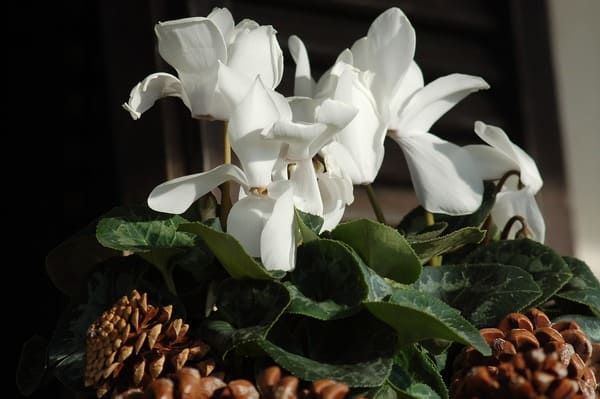

Description
It is a perennial flowering plant of the primrose family. It is distinguished by heart-shaped leaves and flowers on high pedicels. They reach 8 cm in diameter, from white to purple. The smell of cyclamen is persistent and delicate.
There are more than 20 species in the genus. They differ in height from 15 cm to 35 cm, in the presence of double and simple flowers. The homeland of cyclamen is the Mediterranean. But over time, they were spread across many countries.
Grows in Spain, Iraq, in the north and east of the African continent. In Russia, it is found on the Black Sea coast.
How to reanimate?
Cyclamen can be saved only in the early stages of the development of the disease. To do this, do the following:
- Treat the plant with fungicides (chemicals to kill fungi and bacteria) as directed.
- Examine the ground portion and remove the affected tissue.
- Take out the tuber, treat it with a strong solution of potassium permanganate.
- Prepare new soil and transplant the plant there.
- Place in a dark place for 3 days, water in moderation.
Diseases of cyclamen and their treatment with a photo
Cyclamen has three main problems:
- Leaves turn yellow;
- Leaves curl;
- There is no flowering.
Consider briefly cyclamen diseases and their treatment (with photo).
Why cyclamen leaves turn yellow
The reasons why cyclamen leaves turn yellow during flowering may be different:
- Sharp temperature drops;
- Soil depletion;
- Waterlogging or drying out of the soil layer;
- Sunburn.
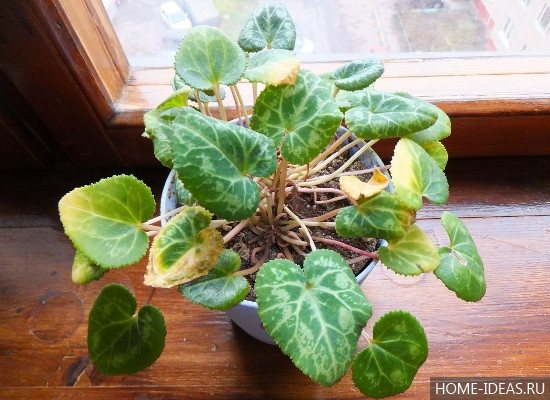

The cyclamen is sick, the leaves turn yellow. What to do in this case? If the tuber is soft and crushed when pressed, then the plant can no longer be saved. In other cases, it is urgent to create optimal conditions for irrigation, lighting, temperature conditions, and nutrition.
Why cyclamen leaves curl
When the question arises why the leaves of cyclamen curl, this should become an alarming sign, signaling one of the reasons:
- Dry air and high temperature - you need to humidify the air and lower the temperature in the room;
- The presence of pests - treat with appropriate drugs or folk remedies;
- Defeat as a result of fusarium wilting or gray rot - remove dry leaves, treat the plant with fungicides, transplant into fresh soil.
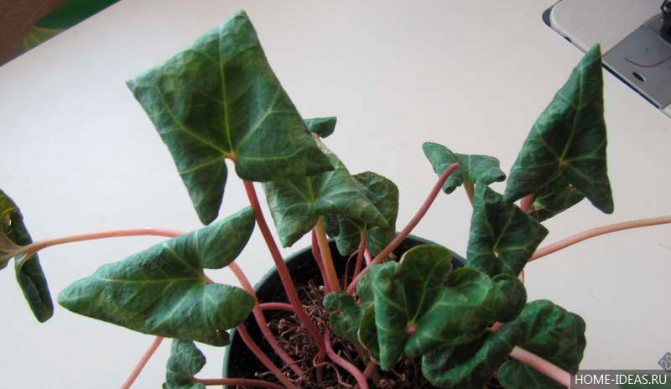

Why cyclamen does not bloom
To solve the problem of why cyclamen does not bloom at home, the following measures should be taken:
- Reduce the air temperature by spraying the plant and ventilating the room;
- Feed the flower with phosphorus-potassium fertilizers;
- Check the degree of burial of the bulb;
- Check if the volume of the pot corresponds to the size of the tuber (3 cm from the tuber to the side of the container).
It is believed that cyclamen forms positive energy, protects the family from conflicts, plays the role of a peacemaker, encourages good deeds, and gives hope. This is how the cyclamen is evaluated by the home care created by its owners.
Answers to popular questions
Do I need to remove the alpine violet in a dark place after flowering?
After flowering, the location of the flower is not changed, watering remains the same. The main important rule is not to fertilize during rest.
Does the alpine violet shed its leaves during rest?
Many people mistakenly believe that the plant necessarily sheds its leaves during hibernation. Far from it. It all depends on the variety and conditions in which the cyclamen is grown. Young specimens may not shed their foliage at all.
Photo
Below you will see a photo of the flower:
Cyclamen transplant
How to transplant cyclamen
The cyclamen is transplanted into a new substrate about once every two years if the pot has become too small on the bulb. This should be done at the end of the dormant period before the start of the active growing season.
- Date palm at home
But remember that cyclamen does not need a spacious pot, it blooms well only in close quarters, when the layer of earth from the bulb to the wall of the pot is no thicker than 2-3 cm.For example, for a bulb 1-1.5 years old, a pot with a diameter of 7-8 cm is suitable , and for a two-three-year-old bulb - with a diameter of 14-15 cm.
In a new pot, put expanded clay for drainage, a layer of fresh substrate, then an onion along with an earthen clod and roots and add the substrate so that the tuber is immersed in it by two-thirds. Tamp the soil well. The transplanted cyclamen will need fertilizers no earlier than in a month.
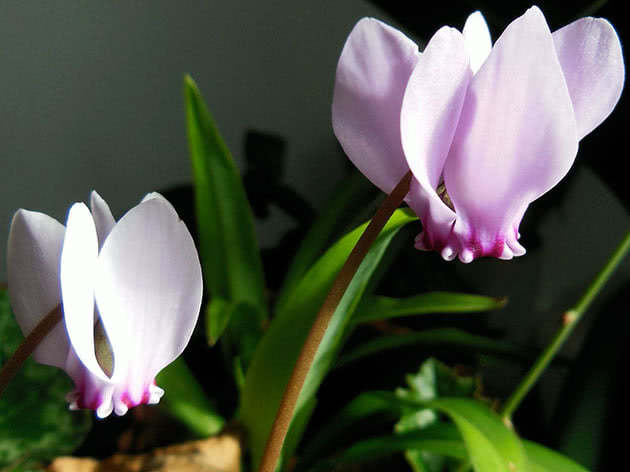

In the photo: Flowering cyclamen
Cyclamen transplant after purchase
A cyclamen is transplanted after purchase only if it is in a dormant period, which is strange in itself - well, who buys an onion buried in the soil? If you bought a flowering cyclamen, wait for it to bloom and rest, and then, at the very beginning of the growing season, if the bulb is cramped or you want to change the technical plastic pot to a beautiful one, transplant the cyclamen in the described way. Or, if the plant does well in an old pot, it is better to put an ugly cyclamen pot in a beautiful planter.
1. Seven Secrets of Success:
| 1. Growing temperature: during the growing season and flowering, cool content at a temperature of 10 to 18 ° C, store the tubers in a cool and dry place at a temperature of 12 to 14 ° C. |
| 2. Lighting: shade from direct rays of the sun in spring and summer, in autumn and winter maximum light is necessary. |
| 3. Watering and humidity: from the planting of tubers, limited watering until the first signs of growth appear, during the period of growth, watering is abundant and regular with drying of the top layer of the soil between them, after flowering and as the ground part dies off, the frequency of watering is greatly reduced. It is best to apply bottom watering. It is desirable to increase the air humidity. |
| 4. Pruning: Sanitary only - remove fading buds to form new ones and extend the total flowering time, as well as old yellowing leaves. |
| 5. Priming: nutritious with a lot of organic matter, loose, well-drained, with a neutral or slightly acidic pH. |
| 6. Top dressing: after the appearance of the first leaves, start feeding with mineral fertilizers for flowering plants every 2 weeks. After flowering, another 1 - 2 dressing is carried out and then fertilization is stopped. |
| 7. Reproduction: dividing tubers in spring transplanting, sowing seeds in spring. |
Botanical name: Cyclamen.
Cyclamen home - family... Primroses.
Where grows... Its origin comes from the Mediterranean.
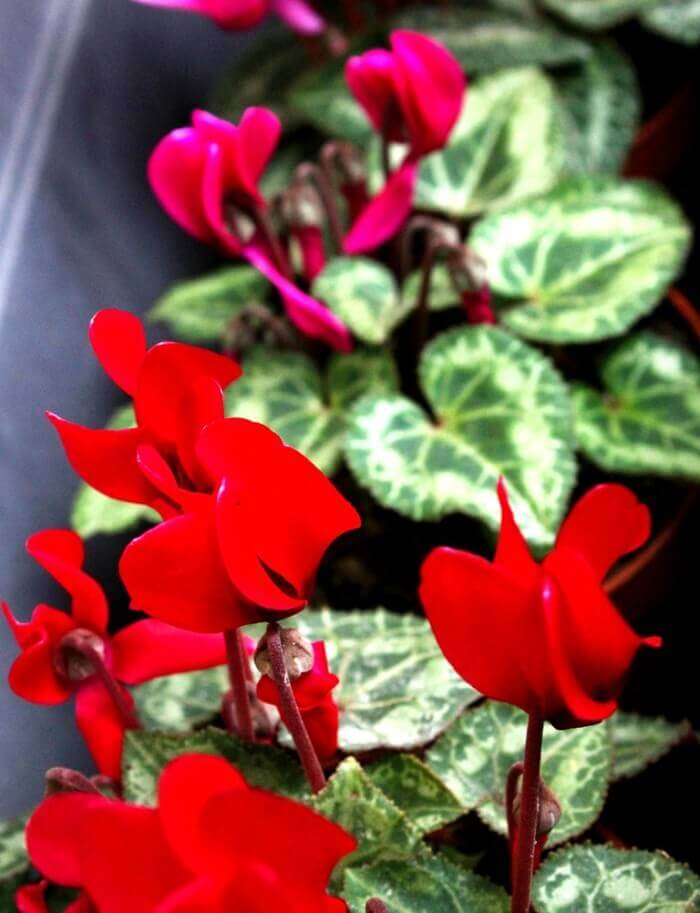

What it looks like. The genus Cyclamen, dryak or alpine violet includes about 20 species of tuberous perennial herbaceous plants.
Leaves small, round or cordate, heart-shaped, very attractive, with long brown petioles. Some species have leaves with broad silvery edges, others speckled.
Flowering is very abundant and long-lasting - the buds almost continuously replace each other. Peduncles rise above the foliage to a height of 25 cm. Flowers pure white or bright red, in all shades of pink, salmon, lilac or violet, some extremely aromatic.
Flowering is very abundant - each bush is capable of producing up to 70 peduncles.
When pollinated, in place of the flower appears fetus - a brownish seed pod, which, as it ripens, will tend to lean more and more towards the ground - while the peduncle will become soft.
The plant looks very decorative even when not in bloom. Currently, there are a huge variety of cyclamen varieties, including those with wavy petals.
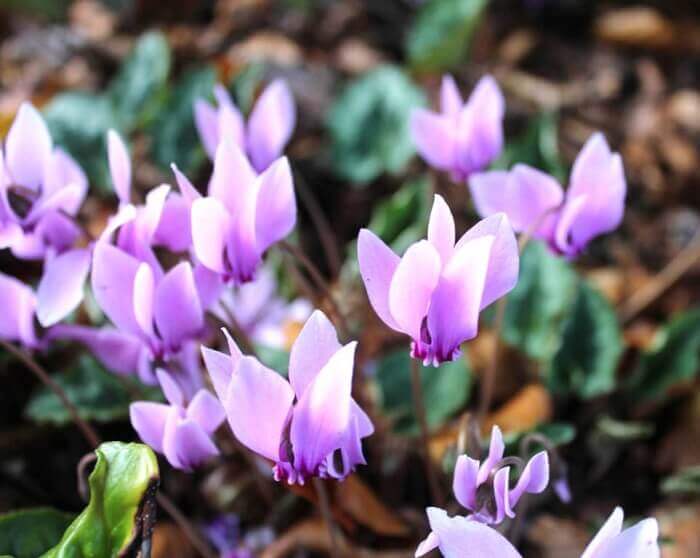

Height... Depends on the variety - high reach 30 - 37 cm., dwarf - 17 - 20 cm.
Homemade cyclamen - features of growing
The cyclamen root is a flattened round corm up to 15 cm in diameter with a single growth point. Damage it - destroy the onion. The leaves of the cyclamen are basal, leathery, heart-shaped, growing on petioles up to 30 cm long, dark green in color with a grayish-silver pattern. The original shape of the flowers is similar to outlandish butterflies - the petals are bent and pointed, sometimes have a fringed shape, and the color palette is incredibly wide - boiling white, pink, all shades of red, burgundy and purple. Cyclamen blooms for more than three months.
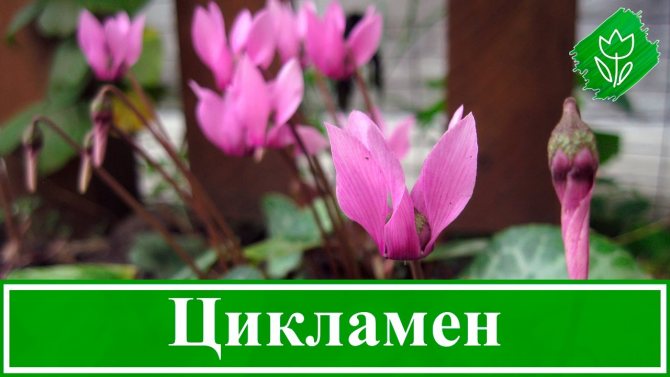

There is an opinion that indoor cyclamen is a capricious plant. Do not believe it! Cyclamen is unpretentious, just in its agricultural technology, as in the agricultural technology of any other plant, there are certain requirements, the mandatory fulfillment of which will allow you to easily cope with its cultivation. So:
- in no case store the tubers of the faded cyclamen in the refrigerator - after such storage, the bulb will not wake up;
- the cyclamen flower does not tolerate heat and stuffiness, but it lives well in a cool room at a temperature uncomfortable for humans - only 6-12 ºC;
- direct sunlight can burn the beautiful leaves of cyclamen;
- do not bury the cyclamen tuber in the ground: at least a third of the bulb should remain on the surface;
- cyclamen does not tolerate an excess of mineral salts in the soil, so be careful with fertilizers;
- a pot for cyclamen needs a small one, so that from the bulb to the wall of the pot there is a layer of soil no thicker than 2-3 cm.
And they often look for cyclamen instead of cyclamen. It's nothing. We will tell you how to grow both that and that flower.
- Indoor fuchsia: care and cultivation
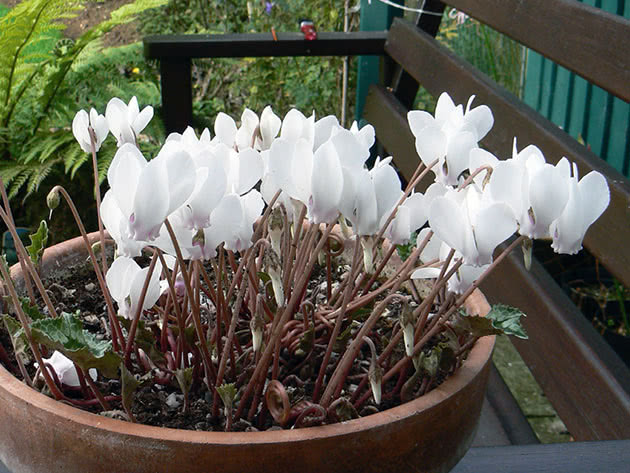

In the photo: White cyclamen in a pot
Signs and superstitions
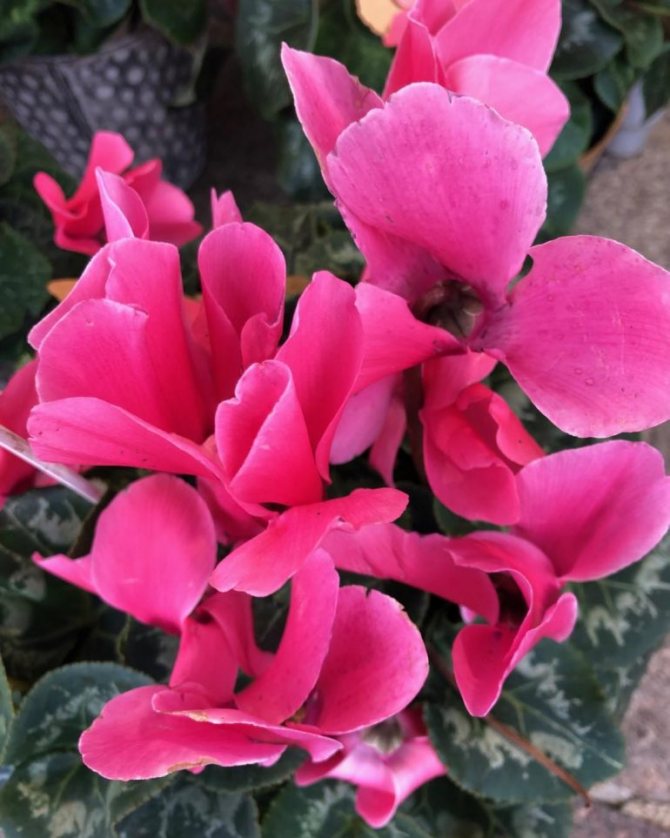

From the esoteric side, cyclamen has a good effect on family relationships. Disagreements in the family between generations will disappear and peace and understanding will reign in the house.
- It has a beneficial effect on the person caring for the cyclamen. It allows you to get rid of sudden mood swings and normalize sleep.
- By placing the plant in the bedroom, the couple will strengthen their bond and be able to have a child.
- The aura of the plant protects against the influence of evil people and their envy.
- People living in a house where there is a cyclamen are gradually getting luck and inspiration, a craving for new achievements and self-development.
- For people suffering from mental disorders, stress, despondency and anxiety, the plant gives peace and good sleep.
How to water after transplant
After transplanting, the plants do not need a lot of moisture, otherwise it will only stagnate in the soil, which is detrimental to the delicate roots. Moisture is introduced as the top layer of the soil dries out.
If the room is too dry (during the heating season or in the summer heat), the aboveground part can be sprayed from a spray bottle, being careful not to get on the flower petals and the upper part of the tuber sticking out of the soil.
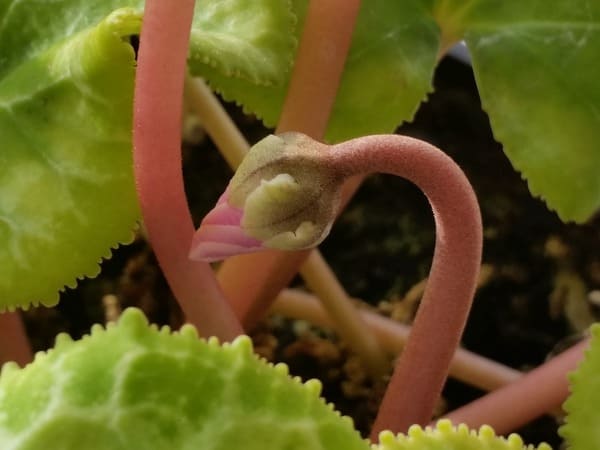

Preparing for transplant
After the cessation of flowering, the leaves of the cyclamen begin to turn yellow, it begins a dormant period. At this time, he is transplanted. To do this, you need to prepare:
- Drainage - shards, expanded clay, brick chips, pieces of foam, gravel are used.
- Soil - you can buy it in a store or prepare it yourself using: humus from leaves, garden soil, sand and perlite. Sometimes a little peat or coconut fiber is added. Everything is thoroughly mixed and sterilized.
- Pot - its size is chosen according to the size of the root system. If roots stick out in the drainage holes, then the new flowerpot must be taken a little more than it was. In a large container, the plant does not develop well and can get sick.
- Activated carbon - used for disinfection of places where roots were cut off. It is crushed before use.
- Sprayer - for spraying roots.
Planting and caring for cyclamen
- Bloom: early spring, autumn, sometimes all year round.
- Lighting: bright diffused light, light partial shade.
- Temperature: 6-12 ˚C.
- Watering: during the period of active growth, regular, moderate, by means of bottom irrigation.
- Air humidity: higher than usual.
- Top dressing: once every two weeks with a solution of complex mineral fertilizer for flowering indoor plants in a weak concentration.
- Rest period: within 2-2.5 months after flowering.
- Transfer: once every two years at the end of the dormant period.
- Reproduction: seeds and dividing the tuber, if it has more than one growth point.
- Pests: spider mites, aphids, thrips, cyclamen mites.
- Diseases: gray rot, rhizoctonia, late blight, fusarium wilting.
Read more about growing cyclamen below.
Temperature regime
When growing many indoor plants, including cyclamen, frequent temperature control is required. A green pet normally tolerates daytime temperatures of + 12-17 ° C.
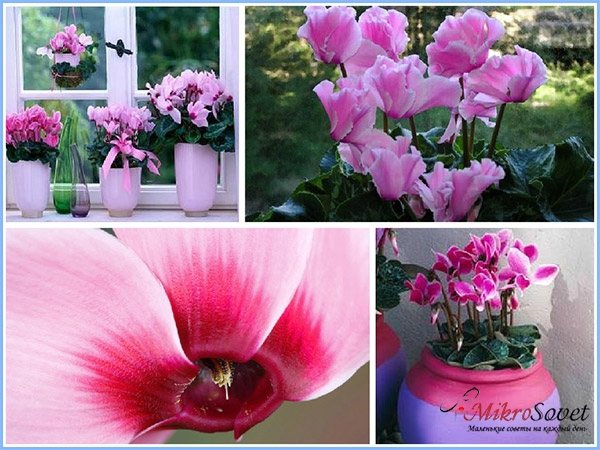

A decrease in the indicator to 10 or an increase to 20-25 is undesirable. In winter, it is better to leave the plant from the battery. For the winter period, a mode of + 12-15 ° C is suitable. In the hot season, it is better to leave the flowerpot in a shady place where the temperature is no higher than + 18-25 ° C.
Flower selection rules
In order not to be disappointed in the purchase, the buyer will need to carefully examine the selected plant. Specimens with sluggish and damaged leaves should be avoided.If plaque is found on the leaves or other parts of the plant, it is better to refuse to buy - there is a high probability that the cyclamen will die and even infect other indoor plants. The bush itself should be dense, dense, with strong stems.
During the period of active flowering, it is worth giving preference to cyclamen with a large number of buds.... Such a plant will delight its owner with flowering longer than others.
Important: The best time to buy cyclamen is in autumn, when the plant has not yet begun to bloom.
Also, that requires close attention - nodules. They should look healthy and fit snugly in the soil. Sometimes we are talking about buying only a flower tuber for growing, and not a grown cyclamen. In this case, you need to pay attention to the growth bud - it must be viable - and the absence of damage in general. A healthy tuber looks dense, weighty.
We recommend watching a video on how to choose the right healthy cyclamen in the store:
How to choose the right cyclamen in the store
Of course, you will want to bring a wildly flowering plant into the house, but it is better not to rush and find a bush where most of the buds have not even thought to bloom, and the leaves do not have the slightest hint of yellowness.
The pot needs to be lifted and the roots are examined, they can be seen from the bottom of the pot into the hole. No rotten roots!
If the soil of the plant is not transportable, but suitable for the plant, then the tuber of a well-planted flower rises above the soil by a maximum of ⅔ in the Persian varieties. The European tubers will be completely underground.
Types of cyclamen
In culture, mainly two types of cyclamen are grown - Persian and European, as well as their derivatives.
Cyclamen European, or alpine violet
This is a tuberous plant with medium-sized leaves and fragrant pink-lilac flowers, but it has varieties of white, carmine and other flowers. In culture since 1607. Cyclamen european is much more tolerant of normal home temperatures than other species, but also prefers cool air to stuffiness. This species does not have a pronounced dormant period, in addition, its tubers sometimes grow daughter bulbs, which can be used for reproduction. European cyclamen blooms from late spring to almost winter, feels great in summer on the balcony or in the garden, but under the obligatory protection from sunlight and from slugs and earthworms entering the pot, for which the pot is covered with an ordinary nylon stocking.
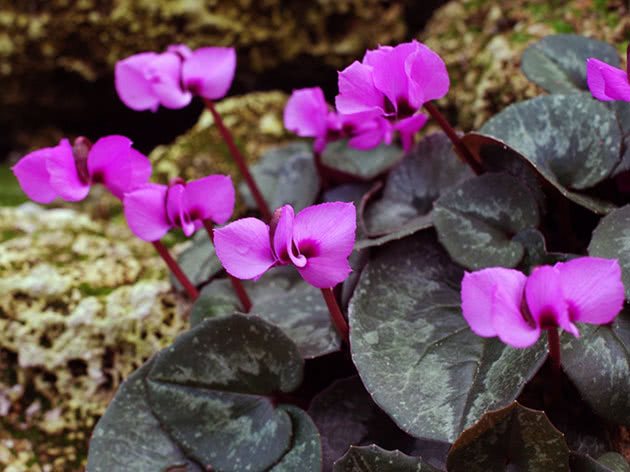

In the photo: Cyclamen European, or alpine violet
Cyclomenia flower. Transplant and care
Cyclamens under the age of three years are recommended to be replanted annually, and adult plants - every two to three years. Drainage is placed in the pot, the layer thickness is 3 cm, then the same soil layer is poured. Cyclamen is freed from the old pot, shaken off the soil from the roots and washed with warm running water. The damaged ones are carefully examined and removed. The cut parts are sprinkled with crushed coal. Excess foliage is removed, the roots are sprayed, straightened and covered with soil, leaving the tuber outside. In the photo - transplantation of a flower of cyclonemia, after which the care is as follows:
- the flower is placed in a cold place;
- do not water for two days;
- watering after transplanting for about a month is not abundant;
- humidify the air around the flower with a spray bottle once a day.
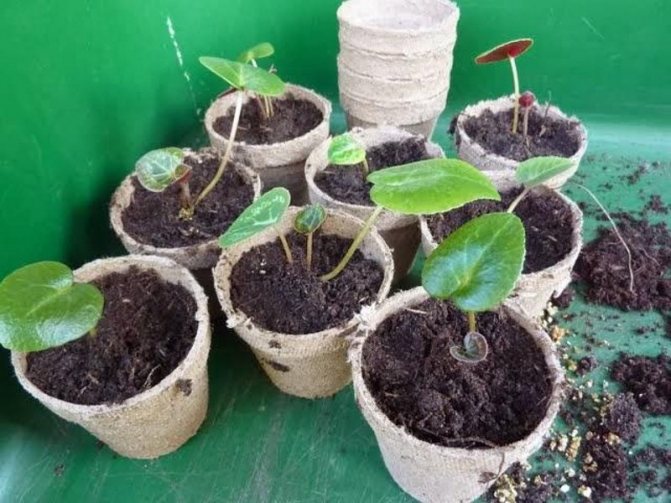

Further, all care procedures are carried out as usual.
Purchased cyclamen pitfalls
Purchased cyclamen is handled with care. Before entering the house, the plant experienced several stresses due to transplantation and a change in the usual climate. The conditions of his detention in a greenhouse are different from those at home. The flower needs to be helped to get used to the new life. A cyclamen transplant after purchase is recommended after 1-2 months. Vigorous peduncles and leaves after a day in the apartment may wither. Do not rush to water or feed them.
The plant adapts to the new temperature and humidity. Choose a cool but bright place for it. Check the degree of moistening of the earthen coma with a dry stick. Pour through the pallet as needed. Fertilizers will not be needed for several months. The fact is that store specimens are over-fed for abundant flowering. Spraying with water with "Zircon" will help the leaves to recover. It is a universal growth regulator that increases disease resistance and root formation activity.
When is a transplant needed?
Indoor flowers are often sold in shipping soil that is not intended for long-term use. It is poor in nutrients, but saturated with a lot of fertilizers. This keeps the plant for a certain time, and then it begins to turn yellow and wilt. Transplantation from such soil is desirable before the end of the adaptation period. It is necessary to change the soil in the following situations:
- noticed pests in the ground;
- poor quality of the substrate;
- decay of plant roots.
How often to water cyclamen
Proper watering is the key to the health and beauty of a decorative flower. The amount of moisture in the soil should be small, but it is necessary to irrigate the soil often, but little by little. During and after flowering, the plant is watered with settled soft water. Do not allow excessive waterlogging or drying out of the earth clod. Buds and tubers should not be wetted during watering. Ideally, a special pallet is used. With excessive irrigation of the soil, the tubers gradually begin to rot.
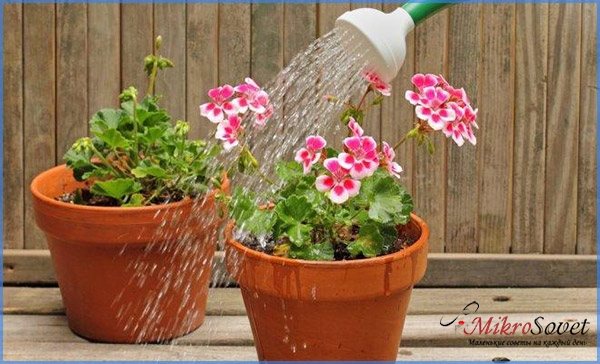

For watering cyclamens, rain, filtered or settled water is suitable. The excess water accumulated under the pot is immediately drained. Watering is carried out less often after flowering, when the plant enters the hibernation period. In the summer months, when the foliage dries up and falls off, exposing the tubers, they cannot be waterlogged. Watering at the beginning of autumn, when the cyclamen is again rearranged from the balcony or garden to the house, the frequency of watering is increased, but gradually.
Content
- Listen to the article
- Features of the
- Growing cyclamen from seeds How to grow
- Planting cyclamen
- How to care
- How to transplant cyclamen
- Enemies of cyclamen
- Cyclamen European, or alpine violet
Ideal humidity for cyclamen
Moisture is an important indicator for the normal growth and development of an ornamental plant. Soil moisture is maintained using a pallet with wet pebbles or expanded clay. You can put a container of water next to the flowerpot. A mixture of coarse sand, turf, peat, vermiculite, clay, leaf humus is suitable as a soil.
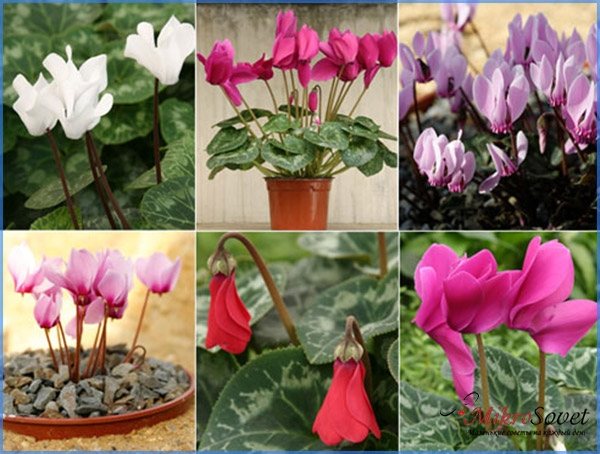

During flowering, do not spray water from a spray bottle onto the leaves. With insufficient air humidity in the room, the foliage begins to dry out. To increase the humidity in a room with flowers, they use water mist near the windowsill, wet towels on a radiator, humidifiers, and small artificial waterfalls.
How to plant a cyclamen
This flowering plant is planted in the following ways: dividing tubers or rosettes.
Separation of tubers:
- the bulbs are removed from the pots and dried thoroughly;
- then they are divided into parts, each of which should have a bud and a couple of roots;
- place the cuttings in a shaded place to dry the slices;
- after disembarking, the pots are placed so that direct sunlight does not fall on them.
Seating with rosettes:
- a shoot is torn from the mother tuber and planted in moist soil;
- stretch polyethylene over the plant to create a greenhouse effect;
- after 14-20 days, young roots appear on the shoots;
- when growing a new outlet, you need to maintain a certain temperature in the room;
- in the future, caring for the grown new outlets does not differ from caring for adult cyclamens.
If the planting process is done correctly, then the flower growers will soon have a whole plantation of cyclamens.
When to transplant?
All kinds of these indoor "pets" are transplanted only after the end of flowering, when they enter the dormant stage. Different types of cyclamens are transplanted in different ways.
The Persian variety needs to be replanted twice a year. In the last decade of May or the first decade of June, it is planted so that the tuber is only slightly covered with a layer of soil. When the leaf rosette grows, the plant is replanted again, with 1/3 of the tuber above the soil surface.
The purple variety should be transplanted every 3-4 seasons in the spring, before the green mass begins to actively grow.
The European species of this flowering plant is transplanted after flowering ends - in the last decade of September.
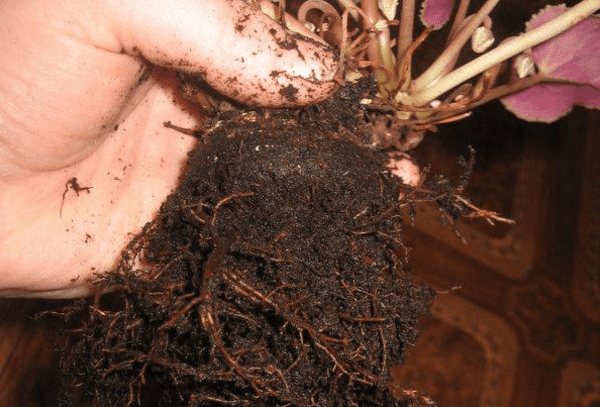

What's the first thing to do?
First of all, you need to inspect the plant again. In the store, it is easy to miss one or another defect, and a fragile flower does not always tolerate transportation well. If damaged leaves are found during the inspection, it is better to carefully remove them, the same is done with faded peduncles.
It is important to remember that not all problems are visible to the naked eye. Pests can also lurk in the ground. To avoid contamination of other indoor plants, the cyclamen needs to find a separate place for a week or two. In addition, preventive treatment will not damage the flower..
3. Varieties:
3.1.Cyclamen small-flowered - Cyclamen parviflorum
A miniature, perennial, evergreen, flowering plant that, unlike most other cyclamens, does not have a dormant period. The root system of this variety has a slightly flattened, dark purple tuber up to 3 cm in diameter. The ground part consists of rounded, basal leaves on long, thin petioles. Leaf blades are entire, glossy, dark green, reaching a diameter of 3.5 cm. Sometimes, small silvery specks can be located on the leaves. The underside of the leaves can be painted in a contrasting burgundy shade. The flowers are purple or pink, with a very pleasant, delicate aroma, appear in the spring.
↑ Upward,
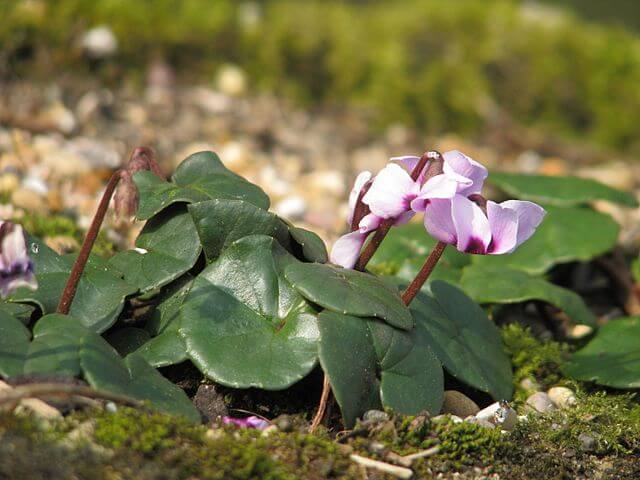

3.2.Cyclamen Colchis or Pontic - Cyclamen colchicum
Plants with large tubers up to 6.5 cm in diameter. Leaves are dark green, heart-shaped, thick. On the surface of the leaf plates, leaf veins are often distinguished with a silvery shade, and a light border is also located around the circumference. The underside of the leaves is colored lighter green. Bright lilac flowers rise high above the leaves on leafless peduncles, have a sweetish aroma.
↑ Upward,
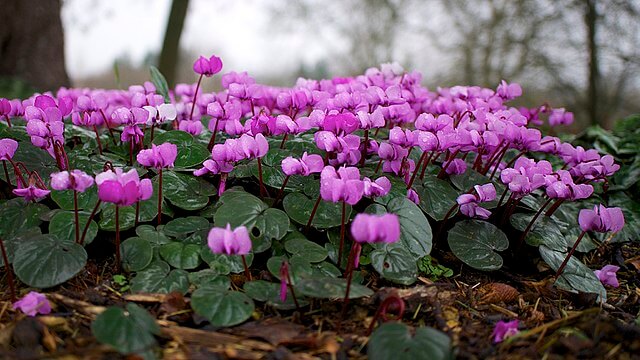

3.3 Cyclamen African - Cyclamen africanum
Perennial flowering cyclamen with one of the largest tubers - in each flower it can reach 14 cm in diameter and has a flattened shape. Leaves are cordate, basal, on strong, burgundy petioles, reach a diameter of 5 - 18 cm, can appear both before and after flowering. The leaf blades have a finely toothed edge and are often dark green with a spectacular geometric pattern on the surface. The flowers are delicate, pink, with a pleasant scent reminiscent of a violet. The bloom is very abundant.
↑ Upward,
